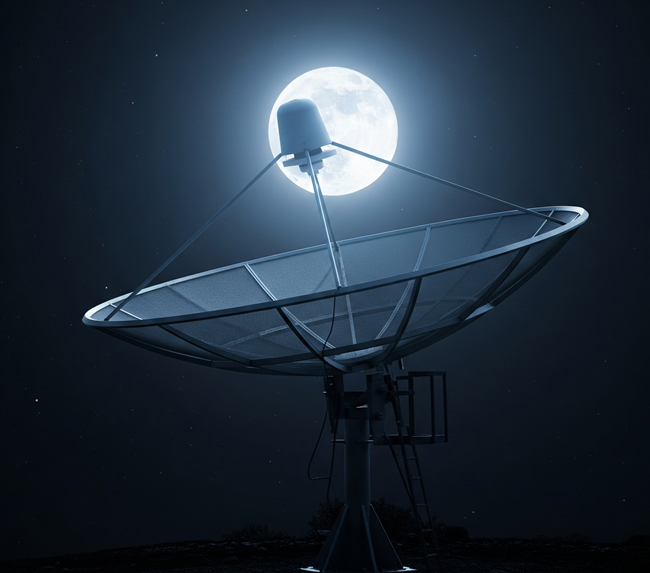
432 AND ABOVE EME NEWS
July 2025
Volume 54 Number 7
Editor: Peter Blair G3LTF
Production Assistance: Frank NC1I & Bob W1QA
NEWS CONTESTS and DXpeditions
G3LTF Editor
It’s sad to have to report the passing in May of Pertti, OH2AXH, a very familiar call on 23 and 13 cm in the 1990s. See his obituary below.
On a happier note, congratulations to Bernie ZS4TX who, with a QSO with NH6V, extended the 23 cm distance record to 19,020 km, see his report below. Alex EA8DBM completed another successful dx-pedition, to Monaco, 3A2, working 82 QSOs on 23 cm and 10 QSOs on 13 cm, a lot of firsts in there I suspect.
There is a threat to our EME operations on 70 cm from AST & Science LLC (AST SpaceMobile) satellites. They currently have five Bluebird commercial satellites that use the amateur radio 430-440 MHz band, for details see here https://amsat-uk.org/2025/06/26/use-of-430-440-mhz-by-ast-spacemobile-constellation/ Their application to the FCC is being opposed by many individuals and amateur organisations. The ARRL is taking the lead as it is the national organisation that liases with the FCC.
Contests
The results of the 2025 Funtests are at the end of the reports section, below.
Unfortunately I haven’t received many reports on the activity in the 10 and 24 GHz Dubus-REF contests, the highest number of QSOs reported on 10 GHz is from OH3LWP with 17.
On 24 GHz DB6NT reports 5 QSOs but I’m sure there was more activity than that, especially as liason was allowed.
In the 6 cm Dubus-REF contest the highest score reported is from OK1KIR with 19 QSOs and several others with 17 or so. Activity was moderate but very low from North America compared to previous years. (OZ1LPR tells me he worked 24 on CW).
Please be sure to get your contest entries in by August 2nd, the format for entries is very relaxed… see http://www.marsport.org.uk/dubus/EMEContest2025.pdf Also please see the note under SM6FHZ’s report, below. If you make a CW QSO which violates the rules then don’t include it in the entry.
The next contest is the first leg of the ARRL EME contest, 2.3 GHz and up, on 16th-17th August see http://www.arrl.org/eme-contest If you operate several bands there is always a problem of which band to be on especially if it takes you a long time to change feeds. There will be high activity on 10 GHz on both days but for the other bands Paul WA6PY suggests day 1 for 6 cm and day 2 for 13 cm and I intend to do that as well.
We have had an early view of the ARI EME trophy Spring section results and the winners are as follows. (Full details on the ARI website soon.)
432 MHz OK1VUM
1296 MHz mixed mode <3.2m dish IK7EZN
1296 MHz mixed mode >3.2m dish G0LBK
1296 MHz CW/SSB <3.2m dish OK2PE
1296 MHz CW/SSB >3.2m dish G3LTF
Microwave bands (>2.3GHz) mixed mode
2.3 GHz OH3LWP
5.7 GHz ON5TA
10 GHz OZ1LPR
DX-peditions
I am not aware of any planned but its good to keep an eye on moon-net.
60 Years Since the Second Arecibo Operation
Below you will find some notes on this, but I also want to say a sincere thank you to you all for the many kind words and congratulations following my request for information on Moon-net, which happened to coincide with my 61st year of EMEing.
Pertti Hohito OH2AXH SK
Jukka OH6DD
 OH2AXH Pertti
OH2AXH Pertti
Pertti Hohtio, OH2AXH, passed away on May 18th 2025 at the age of 79. Pertti got his license and call sign in the early 60s. He became active on EME in the 90s and was QRV on 1.3 GHz - 10 GHz with his 6.4 m dish. He had rigs also for 24 and 47 GHz and was able to hear his own echos on 24 GHz. Pertti was very active on Nordic Activity Contests for many decades and loved to check daily tropo conditions over the Baltic Sea. He was one of the few microwave stations in OH always QRV.
Professionally Pertti made two careers. He was a technical manager at Finnvox Studios and one of the best in Finland engraving music on vinyl records in the 80s. After that he became a broadcast transmission engineer at Digita Oy, subsidiary of the Finnish Broadcasting Company Yle.
Pertti was not active on EME in the recent years but he was still very active on terrestrial contests. He had excellent technical skills and he was always building new equipment. He had some new plans even this spring before he died in an accident.
R.I.P. Pertti!
tnx OH2AUE photo
3A2EME Alex
After extensive preparation and with the tremendous help of Claude Passet 3A2LF, President of the Association des Radioamateurs de Monaco, I was finally able to fulfill my long-standing idea: activating 23 cm and 13 cm on EME.
The biggest challenge was finding a suitable location for the antenna and obtaining permission from the local authorities and regulators. Without the support of the local team — 3A2LF, 3A2OD, and 3A2OK — it would have been absolutely impossible… but in the end, everything worked out!
Since the dish was mounted directly on the car (see picture) and did not touch the ground, there was no need to apply for permission to install it on-site. However, I still faced several complaints, and the police visited twice to thoroughly inspect and ask questions. The funniest moment came during the second police visit: when the moon was at its zenith and the dish was pointing straight up at the sky, someone reported that I was barbecuing on a “giant plate” on the promenade! 😂
Due to the stress and constant interruptions, on the third day I didn’t realize that I had forgotten to connect the antenna coax to the amplifier output. As you can imagine, this had predictable consequences: I ended up losing half the power of my amplifier. Fortunately, by that time I had already worked almost everyone on 23 cm and was ready to switch to the new (for me) 13 cm band.
In total, I logged 82 QSOs on 23 cm and 10 QSOs on 13 cm.
As usual, the full log and detailed report are available on my blog: 🔗 https://ea8dbm.substack.com
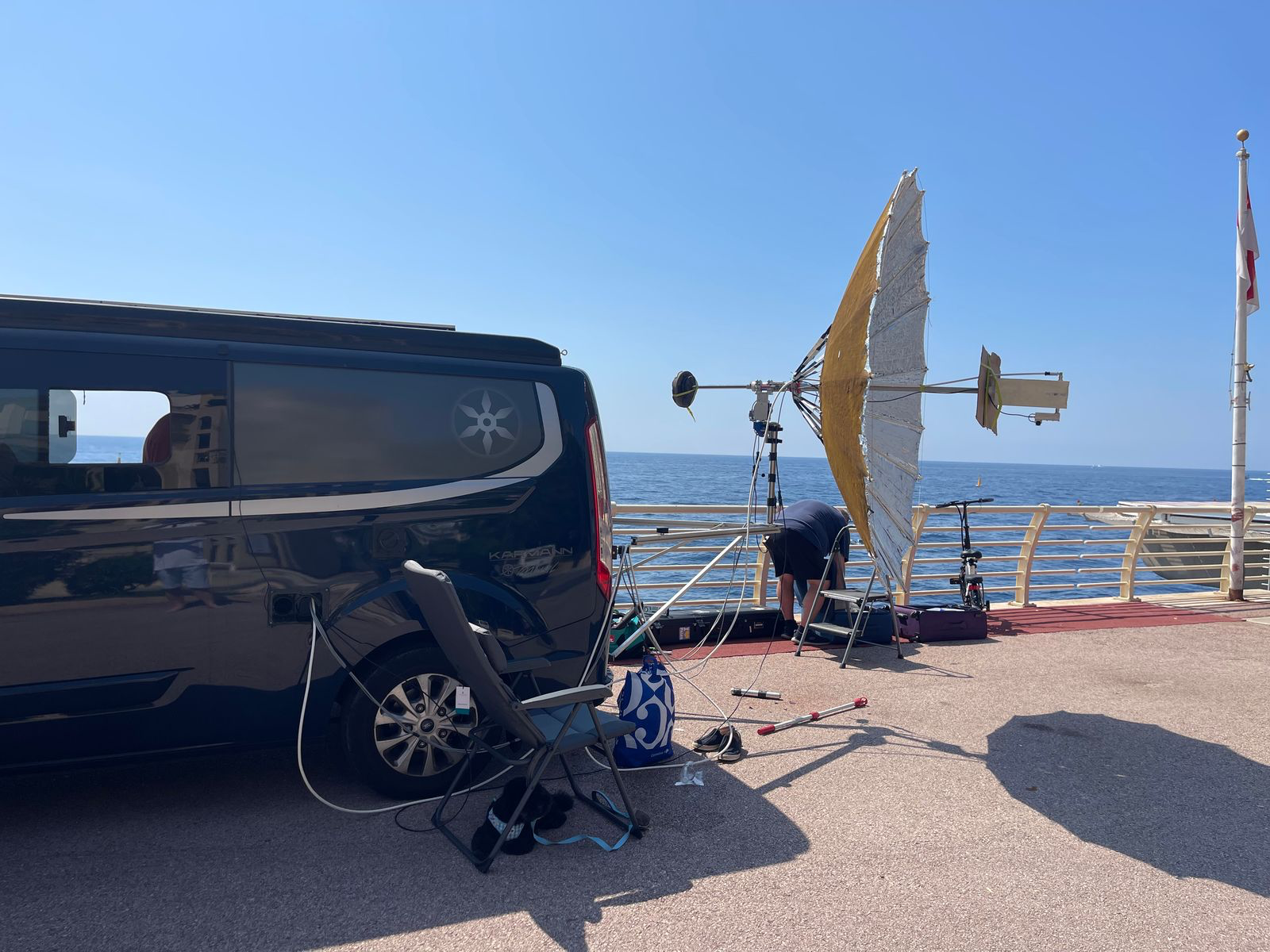 3A2eme antenna setup
3A2eme antenna setup
CT1BYM Miguel
Tests continue at 47 GHz EME. For the first time, it was possible to receive and decode signals between two 120 cm offset antennas. With conditions far from favourable, on 21th June, Hans (DC1EHG) managed to decode my transmission (CT1BYM) and several tests were carried out with other types of encoding. I was using 17W at the feed.
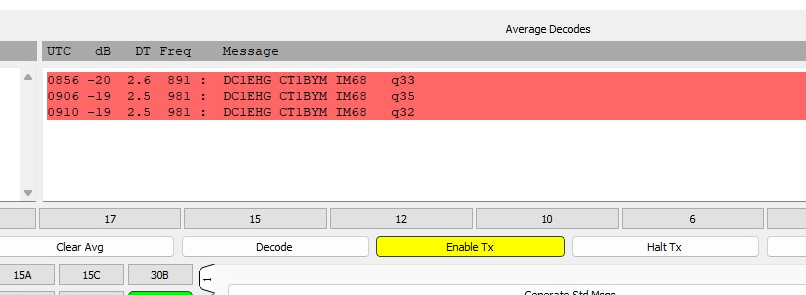 CT1BYM DC1EHG 47 GHz
CT1BYM DC1EHG 47 GHz
We will provide more details about these tests in due course. On 19 July, we repeated the test and, this time, despite Murphy's Law, we achieved a level of -17 dB!!!! Spread was 500 Hz at the time of the tests.
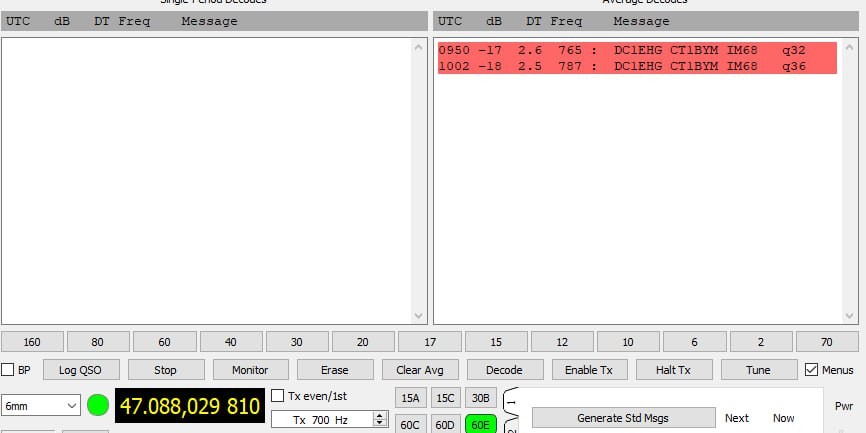 CT1BYM DC1EHG WSJT 47 GHz
CT1BYM DC1EHG WSJT 47 GHz
 CT1BYM system with water cooling pump at the rear
CT1BYM system with water cooling pump at the rear
DB6NT Michael
The weather conditions were very good for the DUBUS contest, and I was able to mount my transverter in the dish on Saturday for the 24 GHz portion. The echoes were clear, and the technology worked very well. I had overhauled my feed and installed a DU3T preamp. This allowed me to work five stations, two of which were new: OK1KIR, OZ1LPR, OH2DG, WA6PY, and SA6BUN. My setup: 3.7 m dish. 1.3 dB NF. 40 W RF out (RW1127).
The next day on 10 GHz, there were 14 stations, four of which were new: OZ1LPR, SA6BUN, SP6JLW, OK1KKD, HB9BBD, ON5TA, F5JWF, HB9BHU, OH3LWP. DL6SH, SP3XBO, OH2DG, F2CT, and G4YTL. My setup: 3.7 m dish. 0.8 dB NF. 50 W RF out.
For the 6 cm weekend of June 2025 I was able to work 17 stations. Last year it was 18. SA6BUN, DL4DTU, SP6JLW, OH2DG, OZ1LPR, ES5PC, G3LTF, PA3DZL, DL1SUZ, ON5RR, OK1KIR, SP3XBO, OH3LWP, SM6FHZ, ON5TA, OE9ERC, WA6PY. My setup: 3.7 m dish, 0.8 db NF, 100 W RF out.
It was a lot of fun. Unfortunately, I was only able to be QRV for a short time (5 hours). Thanks to everyone for the great QSOs.
 DB6NT Dish
DB6NT Dish
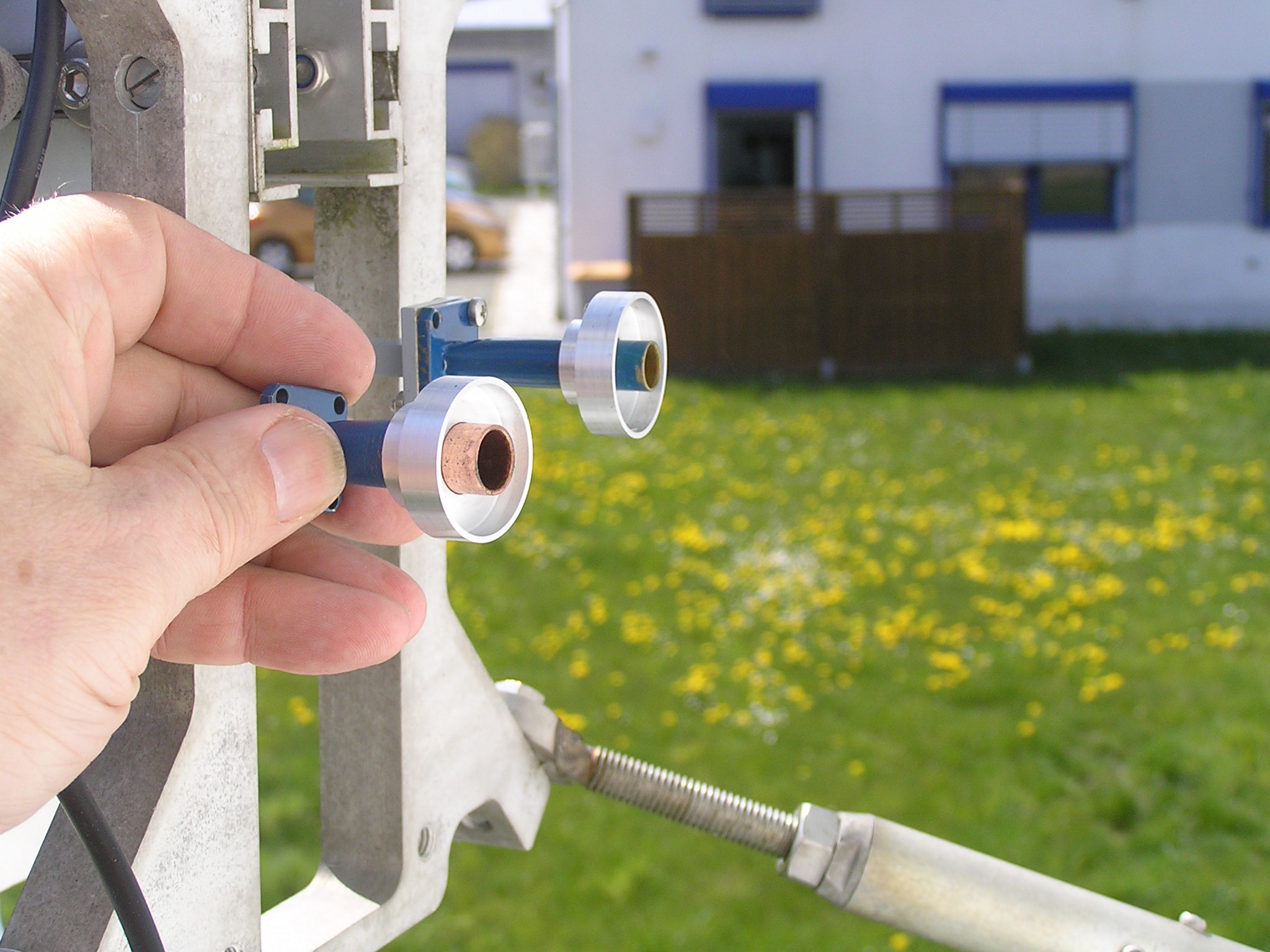 DB6NT Feeds for 10 and 24 GHz
DB6NT Feeds for 10 and 24 GHz
DK0TE Hardy
At the last HAMRADIO 2025, many of you accepted my invitation to a meeting in a quieter atmosphere than the hallway in front of the QSL wall. Significantly more people showed up than expected, so the room was a bit too small. There were about 60 participants in the room, and about two-thirds are visible in the group photo. We had some great conversations, and I look forward to seeing you again next year.
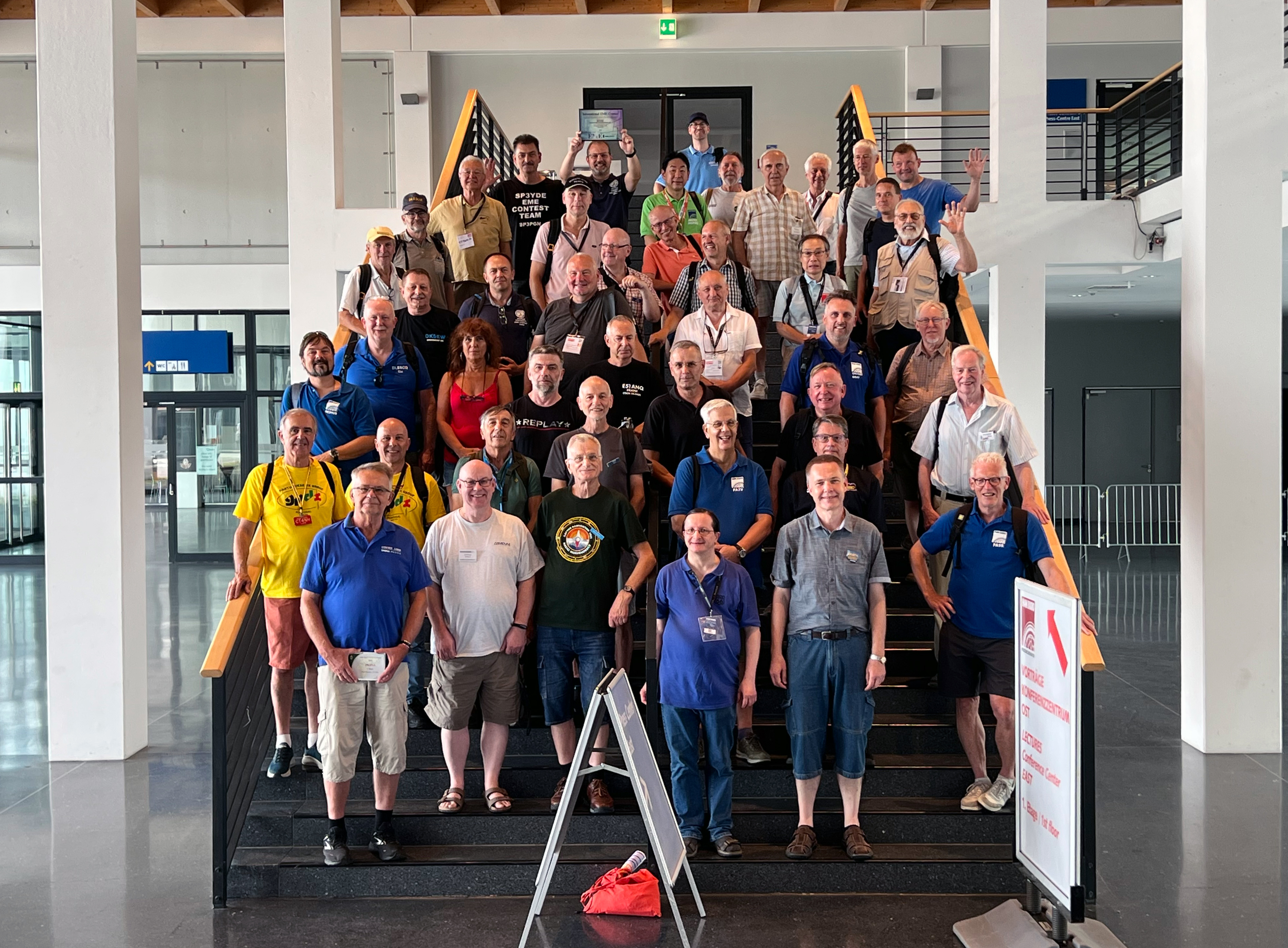 DK0TE EME HAMRADIO 2025
DK0TE EME HAMRADIO 2025
DK3WG Jurg
Worked the following new ones in July:
70 cm Q65-B - RD3FD (now LO05), VE3CIQ
23 cm Q65-C - HG5BMU
DL1SUZ Uwe
Many thanks to Dan and Alex for wonderful job on the expeditions.
KH6FA gave me the 37th WAS on 23 cm. Also very nice to work JA8ERE as new initial on 2 bands. Very nice to work a couple of new initials on 6 cm.
23 cm QSOs: MJ/EA8DBM, AG7CM, IS0/HB9COG, G4RFR, KH6FA, K6EME, MU/EA8DBM
13 cm QSOs: OE5VRL, OE9ERC, IS0/HB9COG, JA8ERE, LA3PNA
5,7 GHz QSOs: IS0/HB9COG, SA6BUN, JA8ERE, LZ4OC, OK1DFC, G4BAO, OE9ERC
G3LTF Peter
I was active on 23 cm CW on 24th June and worked N5TM and G4YTL. On 26th I worked I2FAK #561 and SP7EXY. My next activity was in the DUBUS 6 cm contest on July 19th. The weather was very calm and so my efforts at reducing backlash in the Hour Angle drive didn’t get tested. I had also eliminated virtually all of the slack in the declination control so with the aid of moon noise the dish followed the moon path better than previously. I measured sun noise as 16.3 dB with SF 156.
I worked OZ1LPR, ES5PC, DB6NT, SA6BUN, DL4DTU, OH2DG, OH3LWP, SP3XBO, PA3DZL, SV3AAF, OK1KIR, SP6JLW, SM6FHZ, ON5RR, PA0OLY, SP6GWN and WA6PY. I missed OE9ERC as I was not looking high enough, only up to 5760.125. My error! A total of 17, a bit down on last year and it was dissapointing to not hear more from North America but the hours were not friendly. I was not able to be on for the activity day following the contest.
My 6 cm set up has been the same for a long time, see picture and https://www.sm2cew.com/Moonbouncers/Orebro2017/G3LTF%206cm%20EME%20for%20SM%20Meeting%20.pptx In the block diagram the TS850 has been replaced by a TS590. I run that with 200-150 Hz IF bandwidth and follow up with a tuneable 50 Hz Audio filter at 450-400 Hz. I find that whatever the spreading, bringing in the audio filter gives a noticeable improvement in readability. The SDR enables me to see very small signals pop up and also people calling me off frequency. This IF / Audio system is the same on all the EME bands that I use, 70-6 cm.
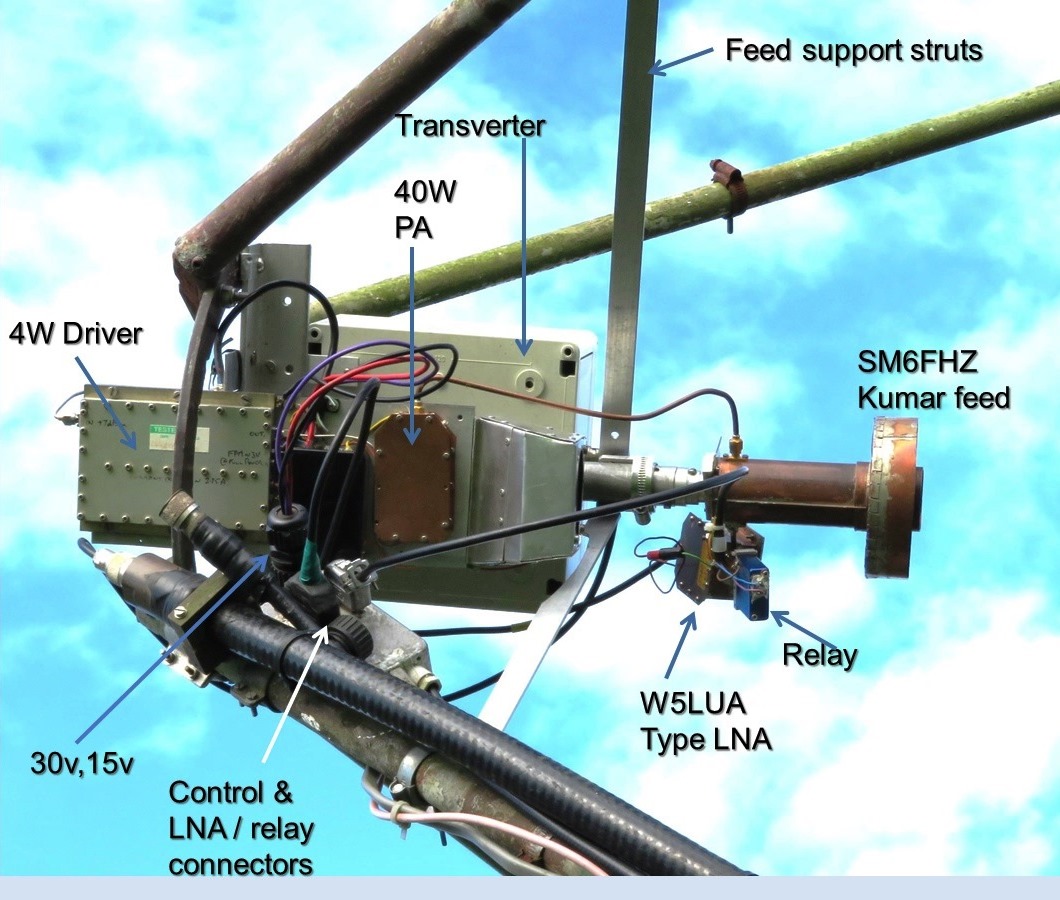 G3LTF 6 cm feed annotated
G3LTF 6 cm feed annotated
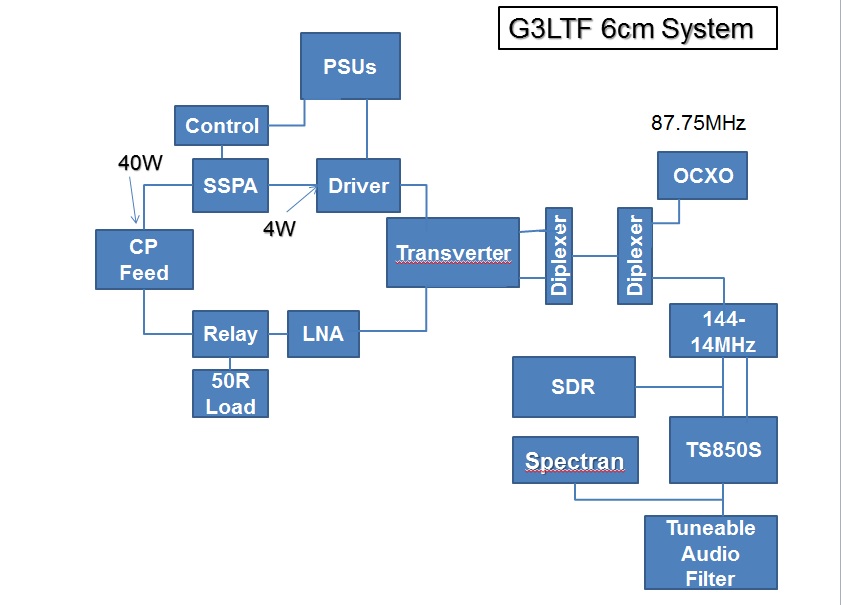 G3LTF 6 cm block diagram
G3LTF 6 cm block diagram
G3YEG Nic
In summary - 37 stations decoded so far, 63 QSOs achieved - majority of which achieved using 9 ele at high elevation in loft. All fully documented on my QRZ page. Best result so far - QSO with Frank NC1I, using 15 ele with 5 w (100 w ERP) at folded dipole feed. See picture of antenna and WSJT screen shot.
Smallest station received on 9 ele :- OZ9AAR who was running just 36 kW ERP at the time.
Strongest station received on 9 ele : NC1I, -11 dB (1 MW ERP) - example of decodes as below.
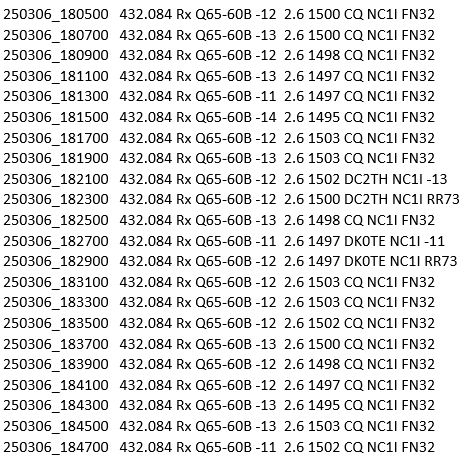 G3YEG 9 el yagi decodes
G3YEG 9 el yagi decodes
Strongest report received using 9 ele and 50 W at feed (600 w ERP): NC1I 01/05/25 -14 (best -11) / -23 (best -22)
Extensive testing with Frank over the last year has resulted in 100% reliability of QSO when using 9 ele at high elevation and 50 w at feed (600 w ERP) - from recent tests it seems likely that just 25 W (300 w ERP) would also result in 100% QSO probability. My receive capability appears to be around 21 dB down on Bernd DL7APV capability and the roof loss incurred is no more that 2 dB.
With normal conditions (Faraday not causing issues) I expect to decode any station running more than 30 Kw ERP and from recent results it seems likely that I may on occasions decode station around 10 kW ERP. Frank and I expect to be able to achieve a QSO with just 5 w using the 9 ele (60 w ERP).
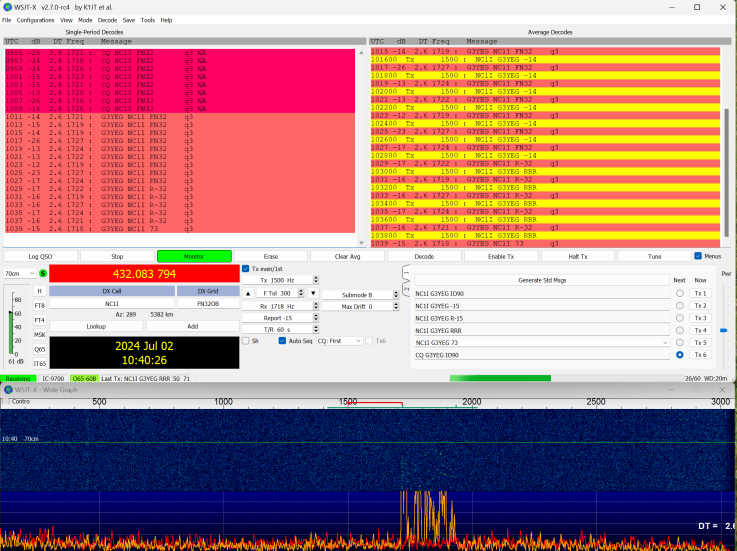 G3YEG NC1I WSJT decodes
G3YEG NC1I WSJT decodes
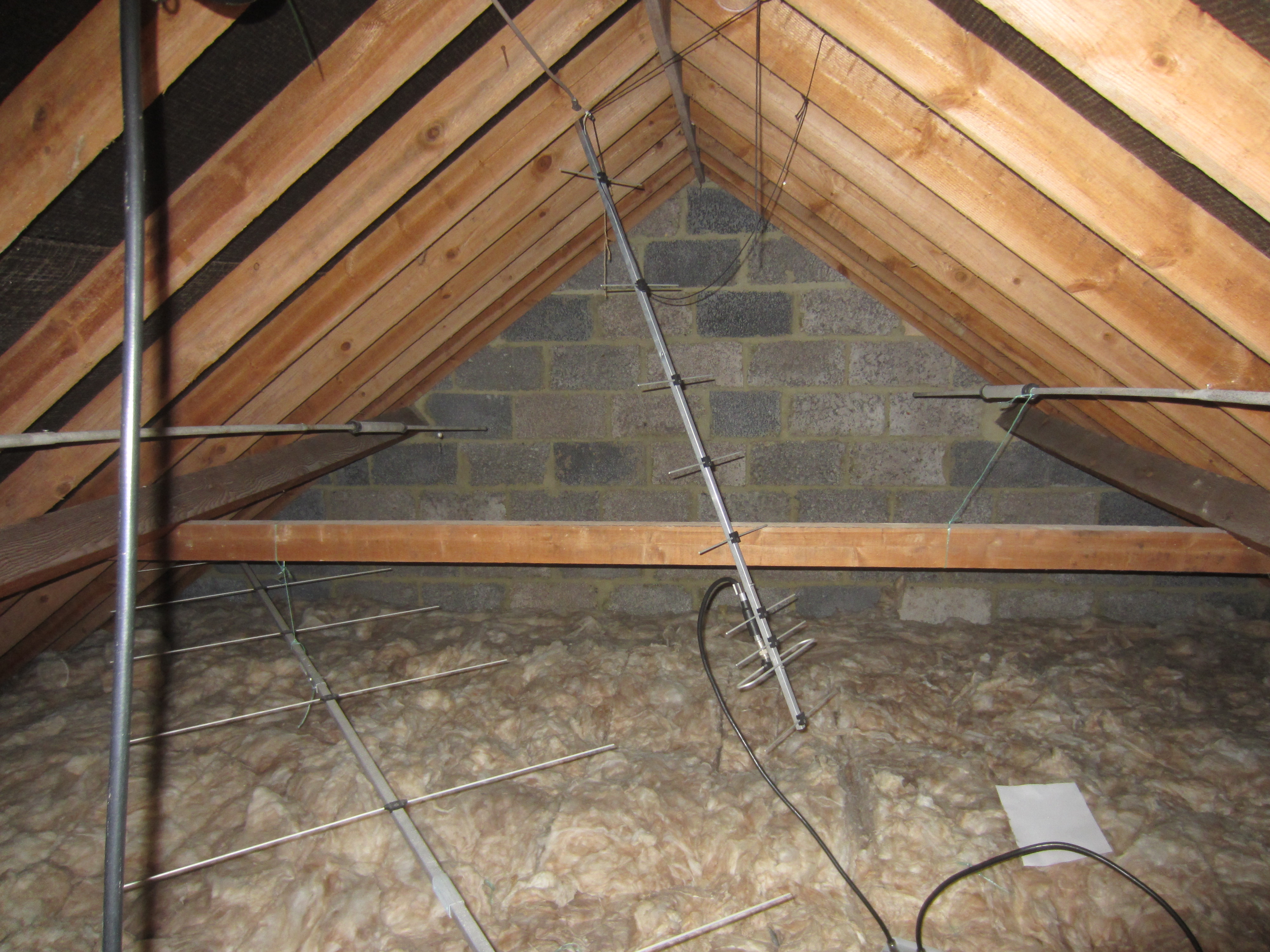 G3YEG 9 el normal ant position
G3YEG 9 el normal ant position
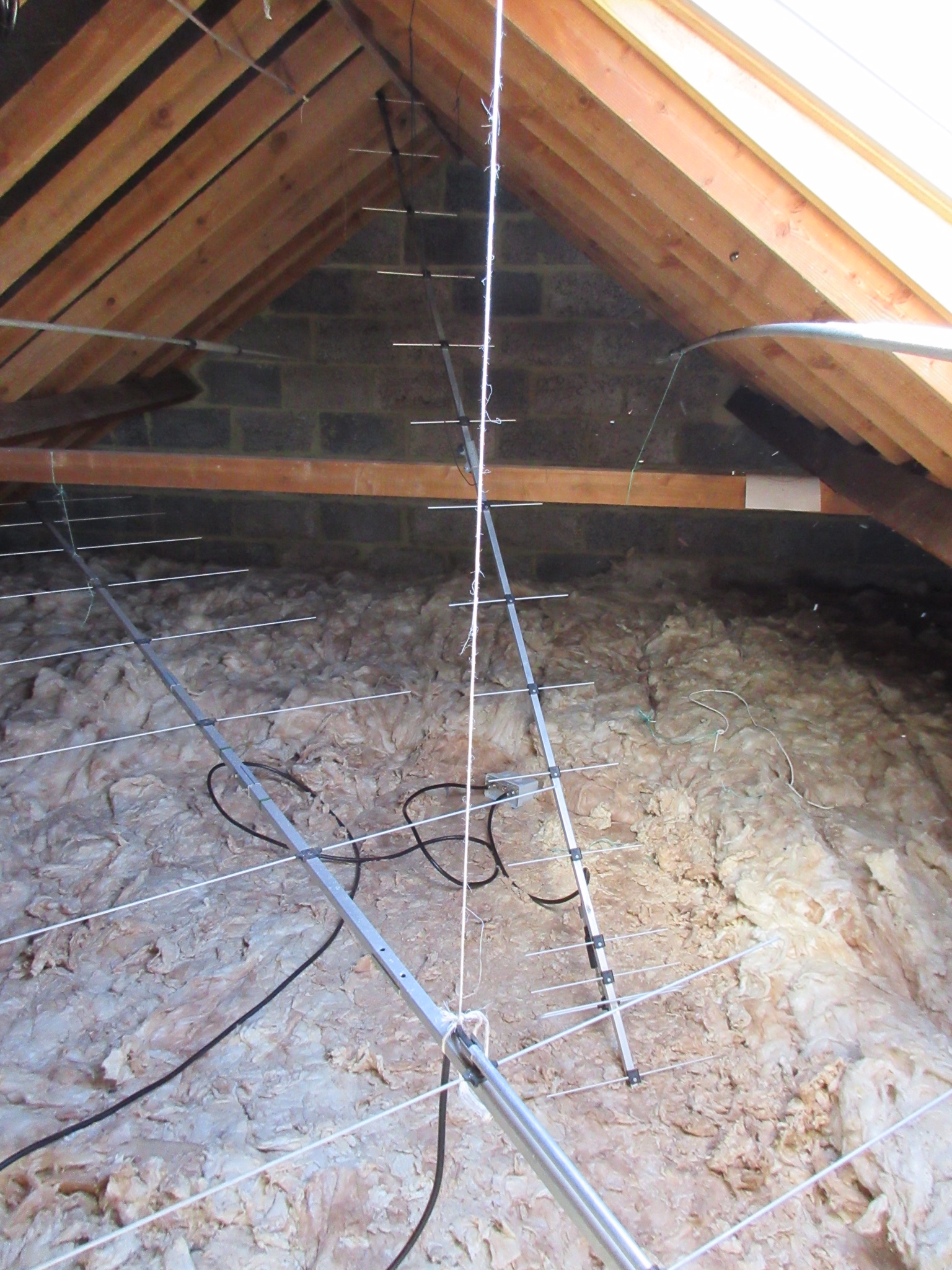 G3YEG 15 el for 5 W QSO
G3YEG 15 el for 5 W QSO
G8RWG Niels
I managed to complete several more 10 GHz QSO's last month using my 1.2 m offset dish, 10 W and DU3T LNA. A few days later I travelled to Ham Radio in Friedrichshafen and it was great to meet so many EME operators face to face, several for the first time.
21 June 2025 ON5TA -12/-16, OH3LWP -12/-21
22 June 2025 CT2GUR -11/-18, HB9Q -14/-17, IK0HWJ -8/-18, PE9GHZ -14/-16, PA0PLY -14/-18. OK2AQ -16/-23, N1AV -15/-25
23 June 2025 EA1IW -13/-19
I2FAK Giorgi
Worked the following new ones on 23 cm during June: YU1DA, BH1TSU, OK2PE (CW), VK3FNI, EA2BRI (DXCC#42), SP7EXV, NY1Y, DK5AI, 3A2EME (DXCC#43), ON4QQ, PA7JB, SP4XU, NH6V, K1WHS, G3LTF (CW), RW9OG, DJ3JJ, GM4PMK, and KD5CHG.
KB7Q Gene
The last month I assembled my collection of 16 magic fiberglass wands and 50 square feet (4.6 m2) of Merlin cloth (aka 2.4 m folding dish) a few times and worked plenty of folks on 23 cm. Band activity has been very, very good. June 22 saw N0LWF (-20 R-19) and K6DIS (-16 R-16) go into the log for new station initials.
July 20th saw especially good conditions right at perigee, and I worked 13 folks in 2.5 hours including PA3EXN (-16 R-17), VE3NXK (-23 R-23), and DL8MAI (-23 R-27) for three new stations to bump my all time 23 cm total to #223. It was well worth rolling out of bed at 3 AM.
Replacing my tired LMR-600 TX line with Andrews 7/8" hardline made a discernible difference.
KN0WS Carl
My only activity this past month was on June 20 when I used Q65 to work N1AV and OH3LWP - both initials on 3 cm from my back yard. I was disappointed in my sun “Y” factor leading up to that date. Apparently the mesh extension I had added to my 6 foot dish to make it 8 foot had distorted under loads of ice in recent years. As a result, this past week I replaced all of the 1/8 inch aluminum mesh with solid aluminum flashing. My “Y” improved by 2.65 dB, but my 2.4 meter dish now still only performs like an ideal 1.8 meter dish on 3 cm! I was going to play a bit with 6 cm this weekend during the DUBUS contest, but lightning storms kept me away from the dish and in bed.
Pictured is my new copper 6 cm septum feed modified from SM6FHZ’s design to use American 1.5 inch pipe instead of the original 39/42mm European pipe. Did not get the chance to test it this weekend.
 KN0WS dish mesh buckling
KN0WS dish mesh buckling
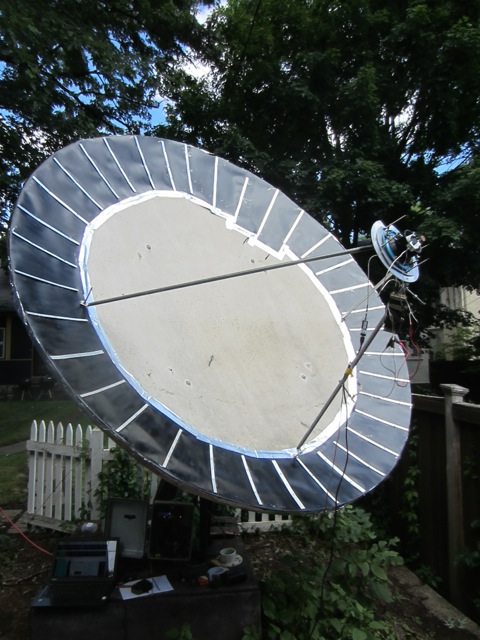 KN0WS painted black solid extension replaces mesh
KN0WS painted black solid extension replaces mesh
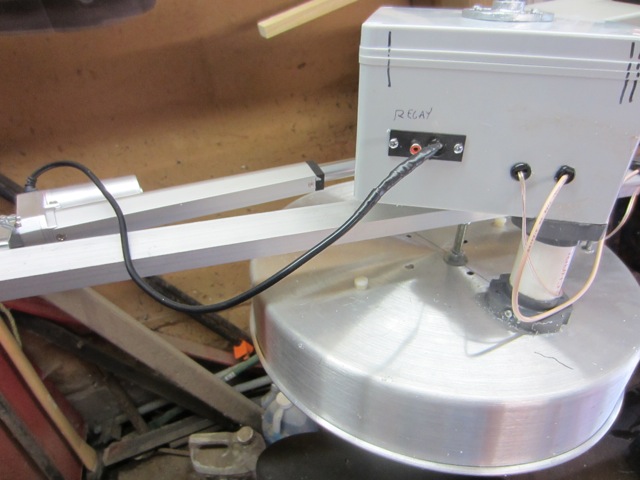 KN0WS 432 feed with remote control parity
KN0WS 432 feed with remote control parity
 KN0WS 6 cm feed modified SM6FHZ design
KN0WS 6 cm feed modified SM6FHZ design
OE3JPC Hannes
I finally finished "WAC" on 23 cm with my 2x56 element yagi station by working ZS4TX - first 23 cm yagi WAC maybe. (Congratulations Hannes, you could well be right! Ed)
The YU1CF yagis do a great job, their G/T is outstanding and absolutely competitive compared with dish stations. I can't install a dish due to space limitations at my small property.
It was quite tough to get the system working properly, continuous tweaking of each component was necessary, especially on the rx side. A major problem is a high power mobile base station blocking LNAs on 23 and on 13 cm. I inserted serial LC (C: air plappers) circuits at the input tuned to the mobile phone frequencies ~900 MHz and ~1850 MHz which did not have an impact on the noise figure but the blocking QRM is totally gone.
OH3LWP Ari
I decided to construct and test a new 3 cm feed with linear polarization for my 4 m diameter 0.385 f/D dish around middle of June. New linear polarization 3 cm feed is based on SM6FHZ 3 cm circular polarization feed with SMA connectors and 0.795 wavelength round waveguide I have previously used. I formed the 0.795 wavelength round waveguide to gradually form into WG-90 waveguide dimensions and soldered a WG-90 flange. I added a VE4MA style choke to the other end with same dimensions as SM6FHZ uses in the CP feed. Photo of the finished assembly is attached.
Best sun to cold sky I have measured with the new feed using Total Power program from I0NAA is 16.6 dB and best moon to cold sky I have measured is 2.6 dB.
Armed with the new feed completed 17 CW QSOs in Dubus 10368 MHz contest 22/06/2025: JA4BLC, HB9BBD, F2CT, OZ1LPR, F5JWF, SP6JLW, HB9BHU, SA6BUN, OK1KKD, OK1DFC, IK0HWJ, OH2DG, ON5TA, SP3XBO, DB6NT, DL6SH, PA0PLY. Heard but not worked JA8ERE.
Completed 14 CW QSOs in Dubus 5760 MHz contest 19/07/2025: SP6JLW, OZ1LPR, OK1KIR, OH2DG, SP3XBO, G3LTF, ES5PC, SA6BUN, PA3DZL, DB6NT, DL4DTU, PA0PLY, SM6FHZ, WA6PY. Heard but not worked JA8ERE and OE9ERC.
Nice activity on 3 cm and 6 cm also outside the contests.
Completed the following QSOs from middle of June to middle of July (duplicates not included):
10 GHz with the new feed:
18/6/2025 EA1IW digital
19/6/2025 IZ4BFA digital, I6YPK digital
20/6/2025 PE9GHZ digital, KN0WS digital
21/6/2025 DL4DTU digital, CX2SC digital, OM4XA digital, G8RWG digital
27/6/2025 SQ9ATC digital, W4AF digital
28/6/2025 CT2GUR digital, UN6PD digital, G4HSK digital, I6YPK digital
1/7/2025 EA1IW digital
15/7/2025 IK6CAK digital
17/7/2025 SA5IKN digital
18/7/2025 G4YTL digital
21/7/2025 PA0JOZ digital, G8RWG digital
5 GHz:
20/7/2025 UN6PD digital, OK1KIR digital, G4IDR digital, SA6BUN CW, ON5TA CW
22/7/2025 JA6AHB digital
On 2.3 GHz highlight was expedition to 3A2
Completed digital QSOs with 3A2EME 22/6/2025
On 1.3 GHz highlight was expedition to 3A2
Completed digital QSOs with 3A2EME 21/6/2025
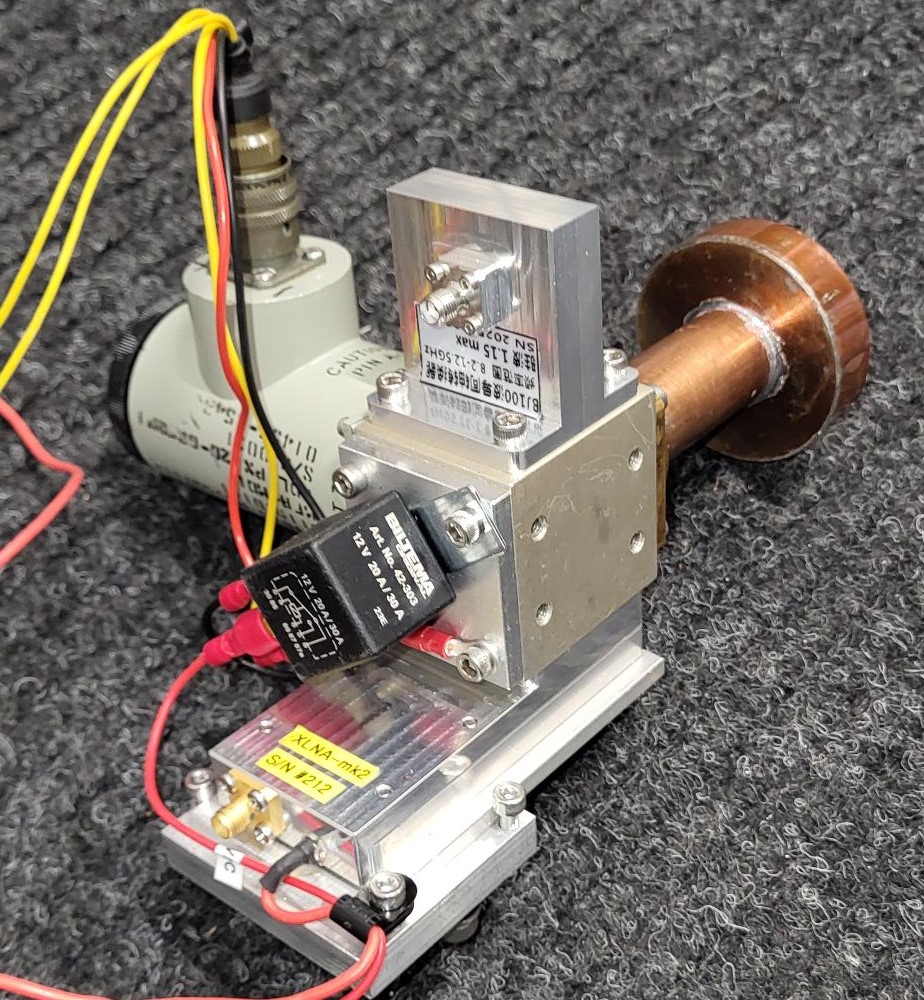 OH3LWP 3 cm feed
OH3LWP 3 cm feed
OK1DFC Zdenek
The June part of the EME window was dedicated to the DUBUS EME contest in the 24 and 10 GHz bands. I originally wanted to participate in the Saturday round on 24 GHz, but work on continuing the 47 GHz system took precedence. On Sunday, I set up the 10 GHz band in a 2.4 m parabolic antenna early in the morning and started CW operation. I managed to make several new initials (list of stations at the end). Conditions were normal, with spread reaching a maximum of 300 Hz, which is not a favorable situation for weaker EME CW signals.
In addition, I also launched a large antenna in parallel and monitored traffic in the 13 cm band, where the expedition 3A2EME was supposed to appear. I monitored both bands simultaneously and made QSOs to the contest on 3 cm in the meantime. However, I was mainly interested in how Alex would hear on 13 cm with the new septum feed I sent him. He appeared after 9 AM UTC. At first, I just called him, but after a while, a decoded message appeared with a report of -27. I thought it would definitely be better. However, the degradation of his parabolic antenna, which had already been used on many expeditions, was very significant, and on the 13 cm band it was even worse than on 23 cm. We completed the connection, and so I recorded a new country, #60 DXCC, both for OK and for myself.
 OK1DFC log
OK1DFC log
OK1KIR
OK1KIR EME during June-July 2025.
Weekend June 20/21 activity started already on Fri, June 20 to catch EA8DBM 23/13 cm expedition to Monaco. On 23 cm we made Alex on June 20 at 10:05 using Q65-30B with great signals (14DB/13DB) as #634 and new DXCC #143. Potential 13 cm operation Alex gave up for technical troubles.
On Sat, June 21 we installed 24 GHz, found Moon at 2 dB with nice echoes, but no stations heard. Found being some 180 kHz off precise frequency. Spending terrible time testing everything. Finally discovered low GPS injection level because small black power supply of GPS distribution amplifier slipped a bit from power line socket! In the meantime JA1WQF lost Moon, so we missed Mitsuo. However we made CW QSOs with OZ1LPR, SA6BUN and DB6NT. CW signal of OH2DG in was unfortunately unreadable in high spreading. Later we swapped to 10 GHz awaiting expected 3 cm activity of KL6M but Mike cancelled it. However, we made at least Q65-60E QSO with PE9GHZ (12DB/4DB) as #276 and CW QSO with HB9BBD (559/569). We were again heard with Q65-60E at SO5AZ (19DB) on 60 cm dish and at OK1IN (12DB) with 90 cm OF dish.
On Sun, June 22 after MR Mike in Alaska finally got operational on 3 cm and we succeeded with Q65-60E at 02:16 KL6M (19DB/17DB) as 1st QSO KL6-OK on 3 cm, #277, DXCC #55, BP field and Alaska as US state #18. No one other was on 3 cm, so we installed 13 cm to await 3A2EME from Monaco. We succeeded with Q65-60D at 09:41 3A2EME (24DB/21DB) as #116 and DXCC #73. We expected much stronger signal from Alex having new septum feed from OK1DFC. It indicates that the surface of his umbrella dish is already significantly damaged after surviving many expeditions.
On Sat, July 19 was Dubus contest 6 cm. We succeeded in coordination negotiations with local WiFi operators and therefore we were able to operate CW after a long time. (Thats excellent news guys! Ed) However, at Moonrise and Moonset at low elevations we still suffer from other distant WiFi signals. Never the less stronger CW stations are readable. We got satisfied collecting overall 19 QSOs from which OH3LWP #128 and DL1SUZ #129 are new initials.
Sun, July 20 was announced as 6 cm activity day. Not too many were active, so we repeated CW QSO with DL1SUZ (549/559) and using Q65-60D we made G4IDR (18DB/14DB) with 2.4 m / 12 W, #74 and K5DOG (18DB/17DB) with 4.4 m / 10 W, #75 as new digi initials. Both days afternoon temperatures were terrible rising up to 34 C.
OZ5TG Verner
It’s never too late to try something new. I have been licensed as OZ5TG since 1968, and have mostly been active on the lower VUSHF bands with contesting and DXing, although there have also been experiments on higher bands like 10 and 122 GHz.
My EME adventure started April 18 2010, when I had an SSB EME QSO with KP4AO on 432 MHz from Arecibo (sad story). The QSL card and voice recordings from that event are highly treasured. My equipment then, was a 5 m fiberglass dish with internal mesh that I was given for free. The dish itself weighed 700 Kg and the supporting system nearly 1200 Kg and was very difficult to manage since it was meant to point to a fixed point. I had to add some features so it could rotate but it was not very good, so I never proceeded running EME. Anyway I managed to make some terrestial QSO’s on 6 cm.
Since then I have replaced the old system with a obsolete weather radar with a 4,3 m solid alu dish, f/d = 0,34 inside a 6 m Ø Radome, so the system now is “indoors” so to speak. That is a giant advantage. Anyway it has been a long journey with endless problems with motor control, some 18 year old production errors, tracking system problems, computer problems and even problems with TeamViewer that don’t believe I’m 78 years old and NOT using the program for business. Anyway there are other solutions that can be brought to work flawlessly, for now I use AnyDesk.
The radio side has been the lesser part of the project, and today I am running 23 cm with a septum feed, a 125 W PA and a G4DDK preamp with relay protection, a DB6NT transverter with 10 MHz OCXO controlled oscillator, and a IC7300 radio. My only major challenge is that the Radome is located 100 m away from my shack, so my 28 MHz IF signal has to travel more than 100 m in coax. That is ca 3 dB loss, but that’s no problem. I also have an ethernet cable with 2 switches after 30 and 60 m to boost the signals. That is used to switch the systems on/off, and to control the tracking system that is a small PC, a home build OE5JFL controller and my own homebrew PWM arduino controlled motor driver.
Having had to build my system the way it is, have have given me the big advantage that it is run 100% remotely controlled whether I run it from my shack at home, or maybe when I visit my daughter and her family in North Carolina, US. It will be fun to try.
After my first 23 cm EME QSO with this system on May 24 2025 and till today one month later, I have made more than 125 WSJT Q65 QSO’s from Hawaii to Western Australia and I'm very pleased with the results. I think my system matches other like systems with regards to sensitivity and reports, and a highly un-scientific average measured over the first 75 qso’s revealed that my average received reports are -13 reports, and I give -14 report. For now I have ca 13,5 dB sunnoise. It should be 15-16 dB, but my septum is for now without choke, and that may give some improvement when installed.
For the time being I will stay on 23 cm untill at least after the ARRL EME contest in Oct/Nov, but I have equipment for 9 cm / 60 W and 6 cm / 40 W and also a 3 cm system with waveguide switch, DB6NT WG-preamp and transverter, and a 15W PA. These will eventually be brought to use as I get familiar with the different bands. I also have equipment for 13 cm, but we have the problem here in OZ that we are only allowed to transmit above 2.4 GHz. If so I have to run split, listen at 2320 and hope that my QSO partners will listen for me above 2400.
Anyway I apologise for the mistakes I have made while learning to use all the systems, and I hope to make many QSO’s with you in the coming years
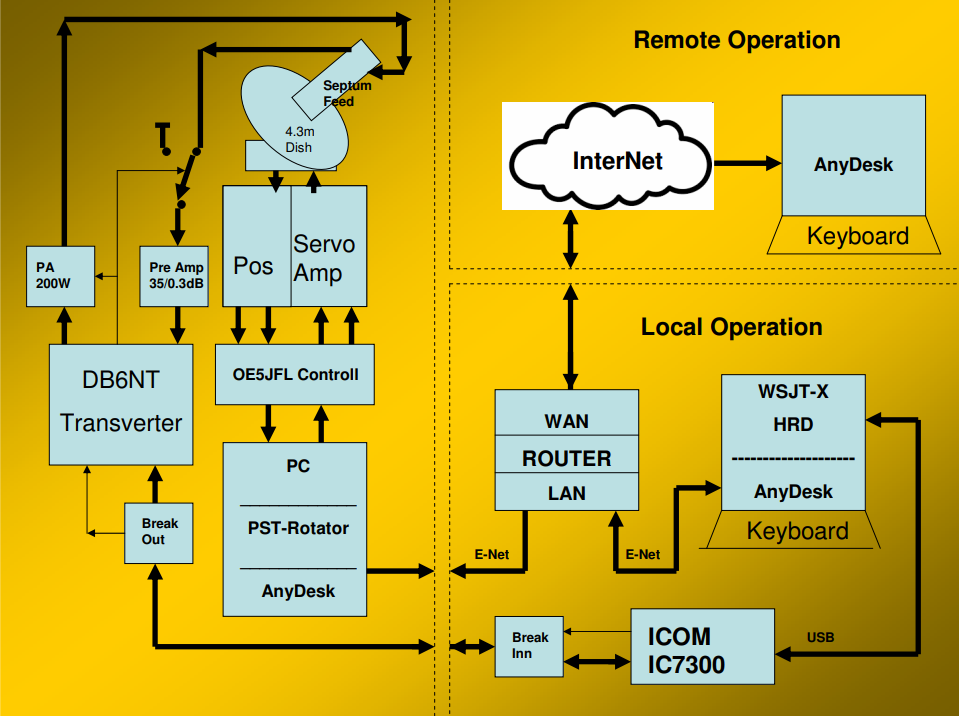 OZ5TG system overview
OZ5TG system overview
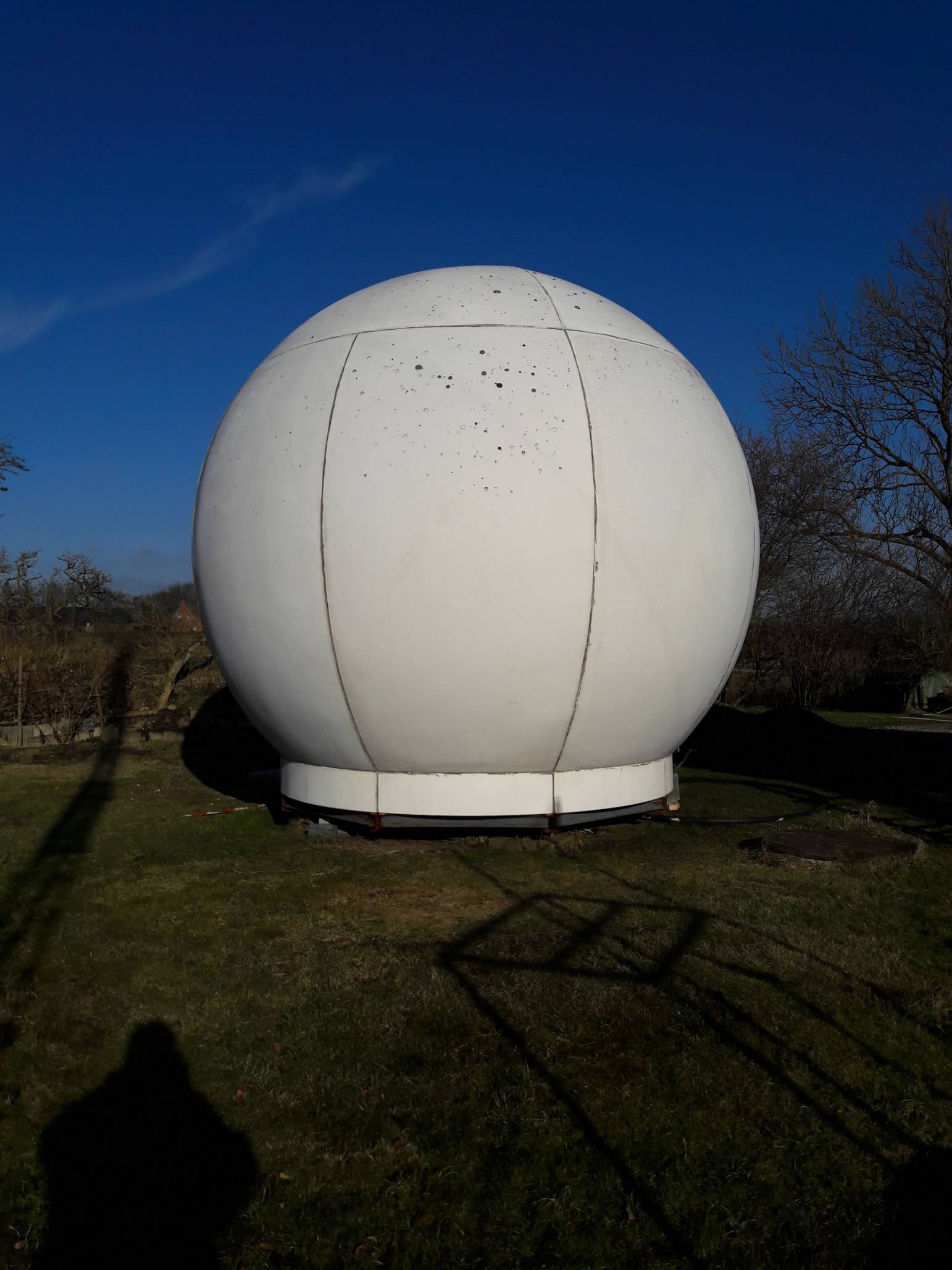 OZ5TG radome
OZ5TG radome
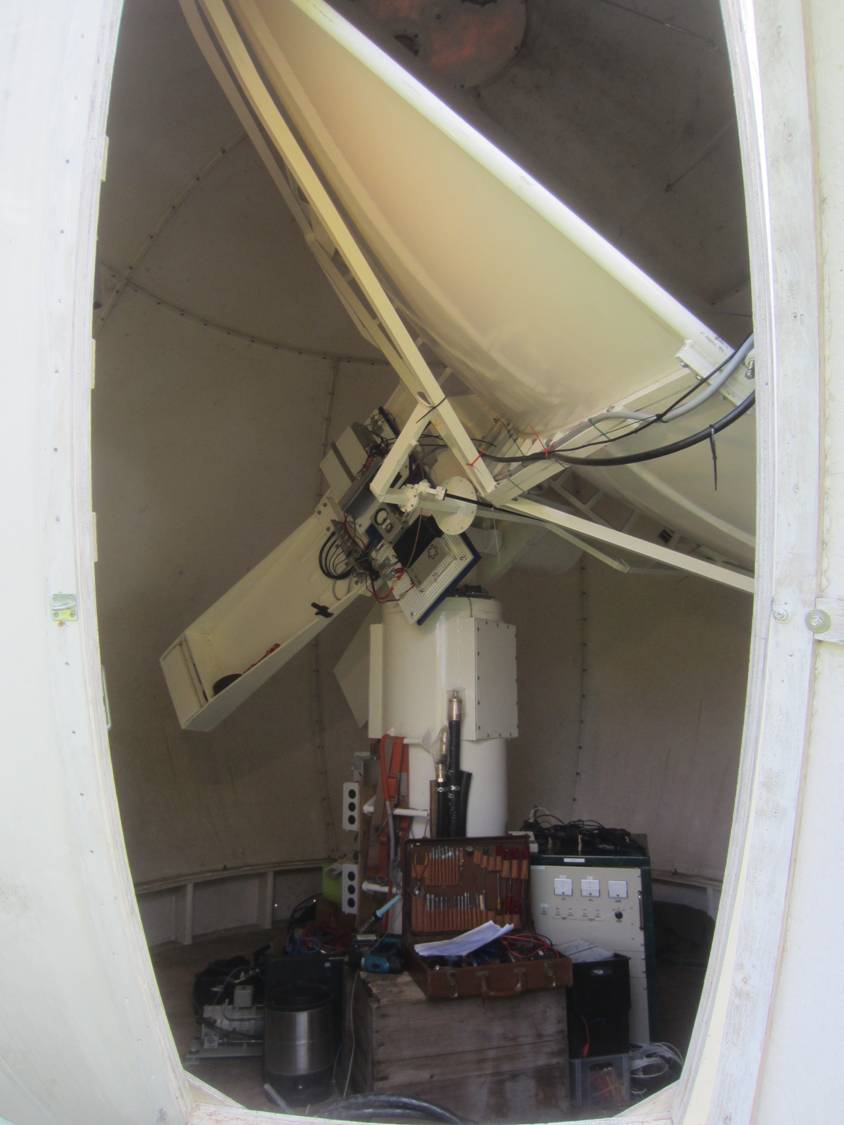 OZ5TG dish inside radome
OZ5TG dish inside radome
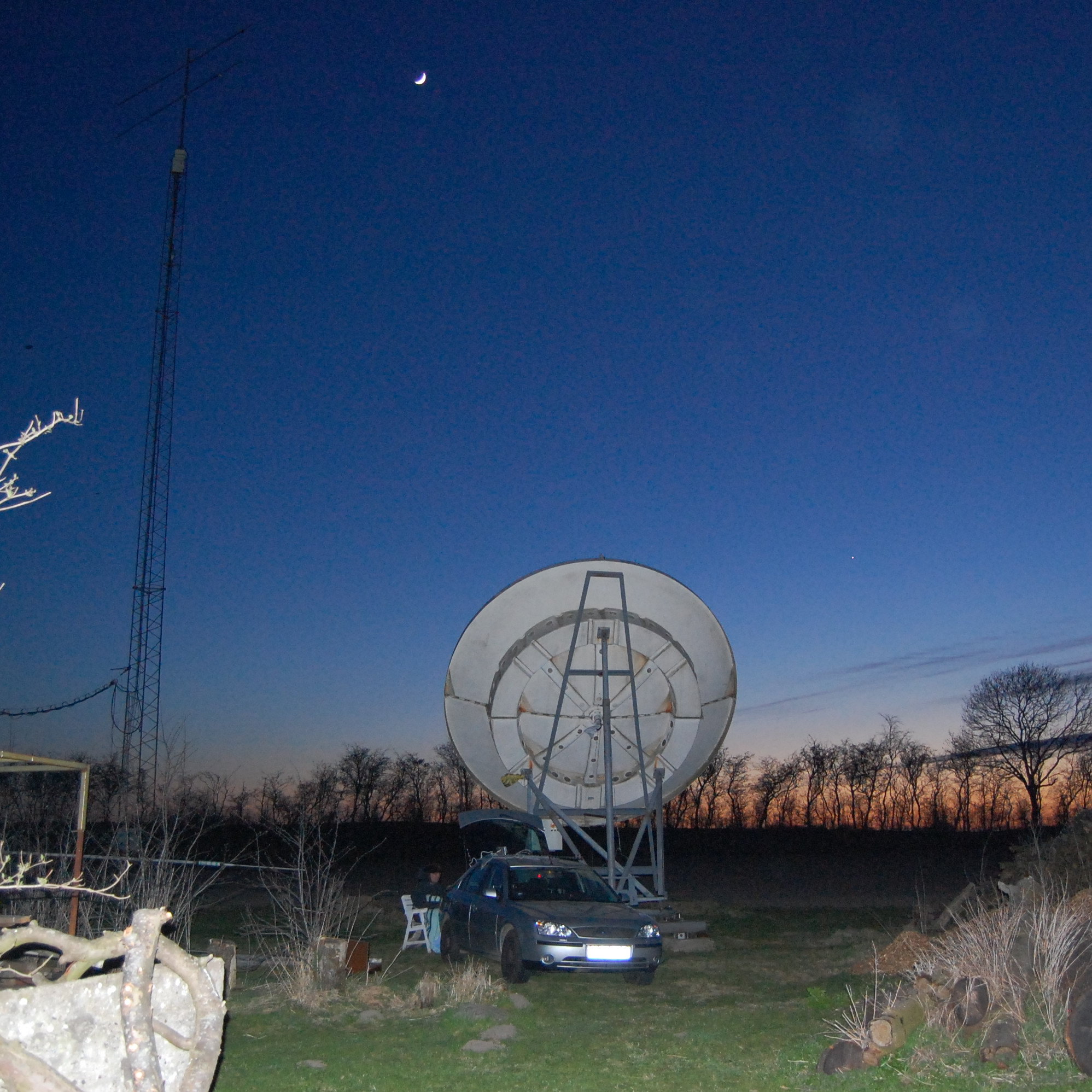 OZ5TG 2010 04 18 First EME QSO with KP4AO
OZ5TG 2010 04 18 First EME QSO with KP4AO
OZ9AAR Carsten
Since my last report I have not worked that many stations on 70 cm EME. Instead, most of my time have been spent on my new 4.8 m dish project and surrounding parts/projects.
End of May I received a wonderful shipment from Zdenek OK1DFC and Václav OK3VM. The parts for the 4.8 m dish and also all the mechanical parts I had designed, arrived safely at my QTH, and in perfect order. A big "Thank you" to Zdenek and not least, to Václav OK3VM. Václav was very nice and responsive (and came with good ideas) during the manufacturing of the mechanics for the dish system.
I started the same day I received the parts, mounting the tower sections. The following couple of weeks I spent mounting the SVH7 Slewdrive and a "thousand" other things. Everything seems to be going together like a big LEGO kit. I'm very happy that I spent so many hours designing all the stuff in a CAD system, it makes it so much more predictable when assembling things.
The comming weeks/months I will spend on making the system ready, still a lot of stuff to be done (currently waiting for a OM6AA type feedhorn from ATT Plus).
All updates are published on my webpage (almost "live" as they happen): https://www.moonbounce.dk/hamradio/ham-radio-current-systems/4.8m-eme-dish.html
Each section on the page are updated as needed, so don't expect that everything new is just added at the end of the page, many of the different (and specific) sections on the page will be updated as the project progresses.
As a "relaxing project" (or when the weather is not "dish building friendly"), I'm making a high power directional coupler (for at least 70 cm and 23 cm), currently have working prototypes, and expect to make a small batch for anyone interested. Preliminary data seems to be quite ok, returnloss is -37 dB to -40 dB and directivity is from 25 to 29 dB depending on band etc.
I still have a few of QRO 90 deg. hybrids for 70 cm and 23 cm available (and the new "low powered" ones), as well as some of my other projects. Most of the stuff can be found here: https://www.moonbounce.dk/forsale.html
Again "a big thank you" to the team making this newsletter happen, well done!
 OZ9AAR 4m8 dish on tower
OZ9AAR 4m8 dish on tower
 OZ9AAR 4m8 dish
OZ9AAR 4m8 dish
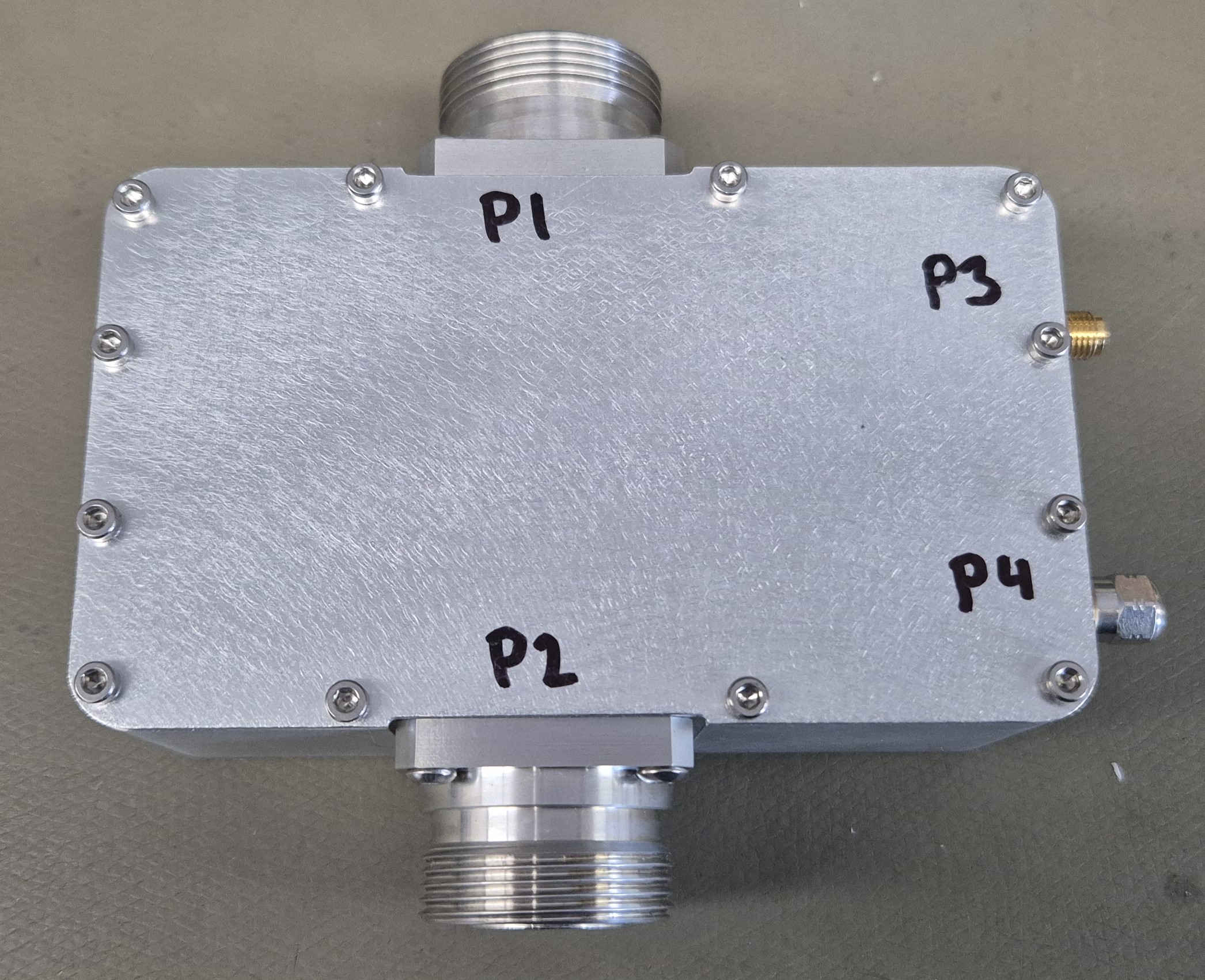 OZ9AAR dir coupler
OZ9AAR dir coupler
PA0PLY Jan
I started to install the 10 GZz gear end of June. The initial check on sun noise showed it was rather poor compared to the previous measurements one year ago. I did change the 3 m coax cable between the focus box unit and the converter, while the rest of the system remained the same. Lucky enough I had another cable, but replacing it did not solve the problem. It was better, but 8 dB SN is certainly not good.
Maybe I am in need of an additional amplifier after the DU3T preamp. The existing one had a 10 dB gain. Quickly checking with Jac PA3DZL resulted in another gainblock with 20 dB gain. After some days, it arrived in my mailbox. Replacing this second stage with an additional 10 dB again did not solve my problem.
Since time went on, and I wanted to get ready for the DUBUS 10 GHz event, I decided to live with the 8 dB SN and only 10 dB secondstage amplifier.
On June 20th I worked PE9GHZ for #106 and guessed my system was not that bad.
On June 22nd I worked: SP6JLW (599/559), OZ1LPR (599/529), OK1DFC (-06/-11) CT2GUR (-16/-18)
That all was in the early morning of the event and I was commented that my signal was weaker then previous. After some thoughts and coffee, I decided to have an eye on the feedpoint position. I can easily access and checking the feed position it became clear there was what Murphy has hidden! The feed was 2 cm out of focus. Re-adjustment yielded in the expected 2 dB Moonnoise and I was very happy again to proceed with the DUBUS contest. I worked: SA6BUN (559/549), HB9BBD (519/549), OH3LWP (519/539) #110, F2CT (529/559), YO2LAM (-10/-15) #107, N1AV (-12/-15) #108, G8RWG (-18/-14) #109 Niels worked with 1.2 m dish and 10 W, NN3Y (-17/18) #111, OM4XA (-18/-22) #112 Fero worked with 2.4 m dish and 4 W.
I also worked with Mike KL6M, although we exchanged reports (-18/-22) we did not finish the QSO correctly. During the CW QSOs I concluded that the spreading on the signals might activate the noise cancelling procedure in my hearing aids. This causes a serious issue to copy CW signals with larger spreading.
After the DUBUS event I worked following stations on 10 GHz:
25 June: SO5AZ (-19/-19) 2 m dish – 10 W #113
26 June: SQ9ATC (-19/-16) 1.8 m dish – 8 W #114
28 June: IZ2DJP (-18/-18) 1 m dish – 12 W
30 June: VK4WYM (-19/-21) 1.2 m - 30 W #115
1 July: UN6PD (-17/-15) 2.4 m dish - 25 W #116
3 July: DL6SH (559/559) 2.4 m dish - 50 W #117
Altough the DUBUS event is meant for CW/SSB and no additional help, there were a lot of stations active in Digimode and using the HB9Q logger. From my conclusion the amount of smaller stations has grown over the last period. Their capability at the moment is not sufficient to run a CW QSO and those hams may probably not improve their station to the required level for CW capability. I understand the beauty of the “old-school” CW qsos and searching around on the band, which is the basic background of the DUBUS activity. However, today with the SDR capability there is no really external help needed to find stations on the band. Using for example SDRConsole and a RTL dongle hooked up to a Bullseye 10 GHz converter will provide an overview of the bandactivity on this band. Expanding the SDRConsole with QMAP it will also decode Digi stations and provide its frequency.
Actually I use a 3 dB splitter after the Bullseye (IF 618 MHz). One output to a RTL dongle for SRDConsole and another RTL dongle for I0NAA moonnoise meter. This configuration is used on other bands as well but connected to a second IF output of the transverter. All is on a separate computer and not connected to the main operator system with my TS2000x.
I am happy to run both Digi and CW QSOs whenever possible. Therefor I would welcome that both modes will be possible to run at events such as the DUBUS events. Maybe make it a seperate category, but with the goal to generate activity.
After this DUBUS event, I prepared my stations for the DUBUS 6 cm event end of July. Did check MN and SN and the feed position, of course. All was fine and I was ready for an early start at July 19th. Compared to the 10 GHz event, I was surprised to see so much CW activity and only a few Digi stations during this event. I worked: OK1KIR, OZ1LPR, SP3XBO, SP6JLW, SA6BUN, DL4DTU, ES5PC, PA3DZL, OH2DG, OE9ERC, OH3LWP, SM7FHZ #57, G3LTF. All in CW. Heard ON5RR, but could not find Marc later. Tried with WA6PY for over 30 min but Paul kept sending QRZ??, while I copied him 529. (Consulting Paul after the event, he told lots of local interference got him away from proper copying my signals.)
Following stations were worked in Digi mode: JA6AHB, OK1KIR, ON5TA, DJ7FJ, DL4DTU, G4IDR (2.4M-12W) #56
The Sunday moonpass was disappointing with very low activity anyway. From the US side only Steve K5DOG showed up and we made a lot of fun. Steve prepared a off the shelf station based on a 4.4 m dish and 10 Watt. He worked several stations but my signal did not arrive on his decode. I copied him at best –18dB. I did work OE9ERC (-02/-12), my pointing was off for a while. Erich was +2dB at best and Uwe DL1SUZ (-16/-15).
Coming period I will work on the new 9 cm station for PI9RD. The feed is shadows by the large Focusbox on one site and the tracking algoritm has to be checked for this feed, hanging off-focus.
My new 9 cm station is based on the SG-labs transverter and DU3T SSPA-100W. I hope to finish this in a few weeks.
As usually I updated the EME database on July 15th , any furhter additions and changes are welcomed.
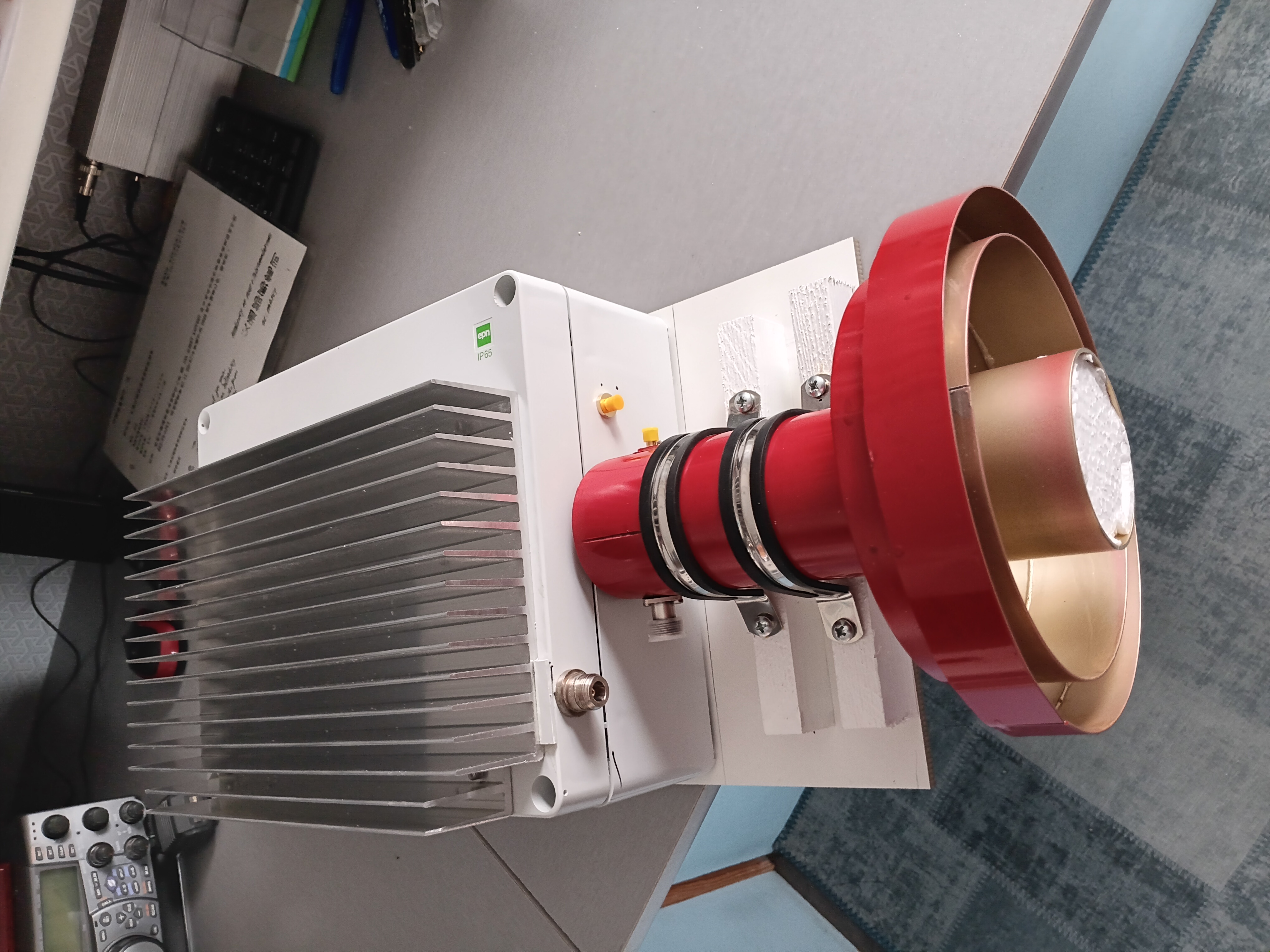 PA0PLY 9 cm system
PA0PLY 9 cm system
PA3DZL Jac
1296 MHz end of June activity
Worked: 3A2EME for an initial and NEW DXCC # 116, K3SK and OZ5TG
2320 MHz activity 22nd of June
Worked: 3A2EME for an initial and NEW DXCC # 58, also a FIRST QSO ever on 13 cm between Monaco and The Netherlands
5760 MHz activity on the 19th of July DUBUS CW/SSB Contest - I was QRV for 5 hours
Worked in CW: ES5PC, ON5RR, PAØPLY, OZ1LPR, SA6BUN, G3LTF, DB6NT, SV3AAF, SP3XBO, ON5TA, SM6FHZ, OK1KIR, SP6JLW, DL4DTU, OH3LWP, DL1SUZ and WA6PY
Outside the contest in Q65 Digi Mode on 5760 MHz
Worked: G4IDR # initial 106, UN6PD and K5DOG # initial 107
Great to meet Dave G4IDR and Steve K5DOG on 6 cm off the Moon, a very good FIRST SHOW from both! CONGRATS guys!
I was in Friedrichshafen June 26 - 28, at HAM Radio 2025 and met a lot new and old Moonbounce friends. Had a great time, was there together with John, PA7JB and Frank, PA2M. We couldn't be there during the short EME meeting because we were at the Flea Market.
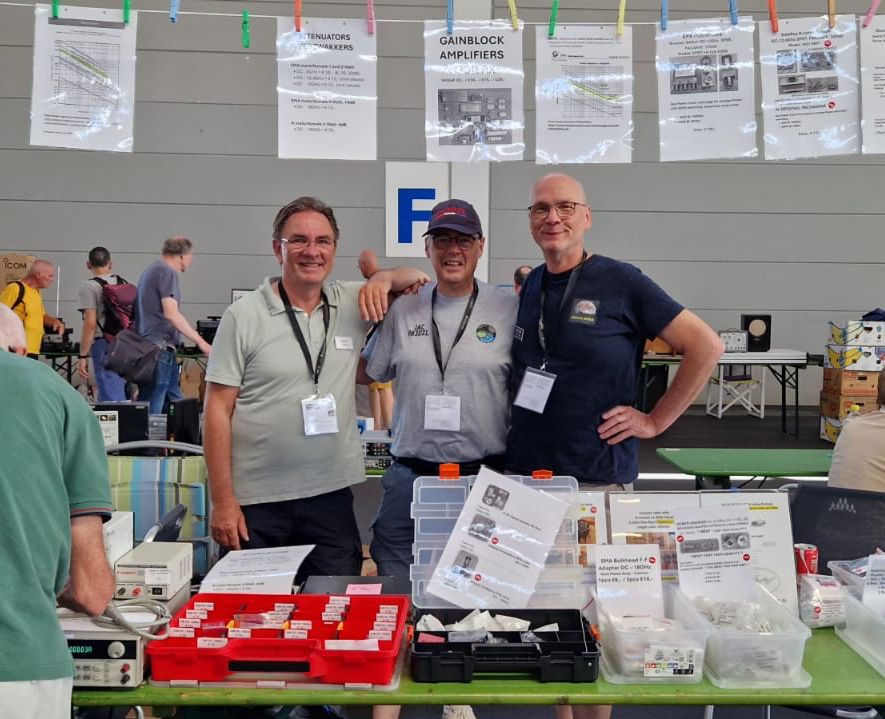 PA2M PA3DZL PA7JB Ham Radio 2025
PA2M PA3DZL PA7JB Ham Radio 2025
PA3EXV Gerrie
Finally, I was able to complete a QSO which was on my bucket list for many months: KH6FA in Hawai on 23 cm, my initial #246 since I started 23 cm EME July 29, 2024! I am sure many of you have worked Frank already, however my local situation during the small moon-window we have limited me always. In the afternoon of July 22, I saw Frank was again QRV in the HB9Q-chat, like a few days before. I was almost sure I couldn’t complete the QSO, like so many times before because of the trees in front of my house. In this case the saying “Nothing ventured, nothing gained" was of value, so after half an hour calling from both sides we got good decodes! It must be the small gap in the leaves of the tree, anyway it was a great success. My dish was already half covered by the roof of the house as well, so signals weren’t as strong as with unobstructed paths.
My station consists of a 3.5 mtr home build mesh dish with 6x6 mm square mesh, good at least up to 6 cm. QRV already on 23 cm with W6PQL SSPA and on 13 cm (4 x MRF21085 limited now to 125 W). Building in progress for 9 cm with the old equipment bought from John, G4BAO (transverter with 2x Toshiba UM2864A modules). Also 3 cm preparing by participating in the build of the F6BVA transverter. Mesh-dish construction on my website, next to other projects: https://www.pa3exv.nl
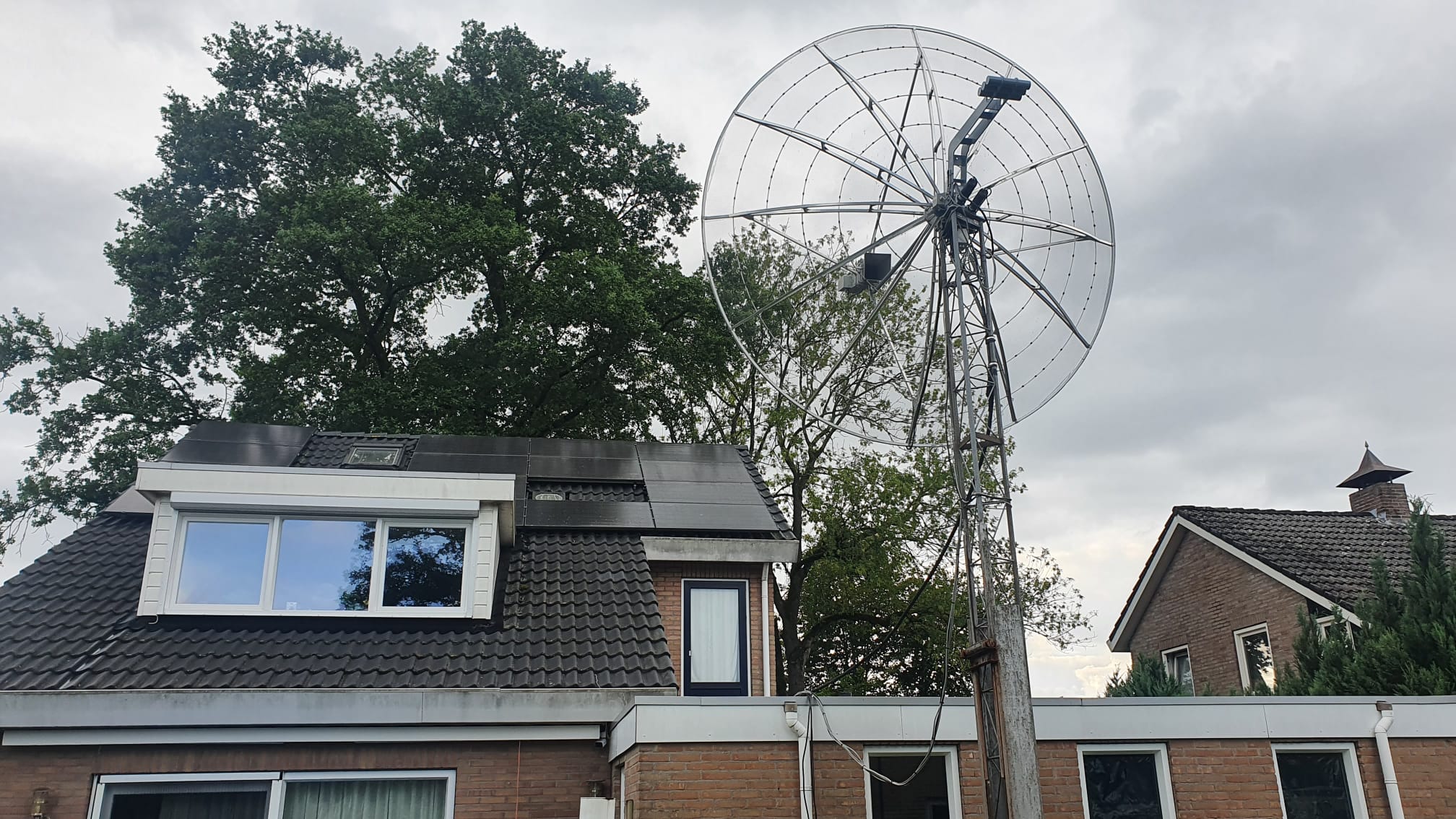 PA3EXV KH6FA dish through trees
PA3EXV KH6FA dish through trees
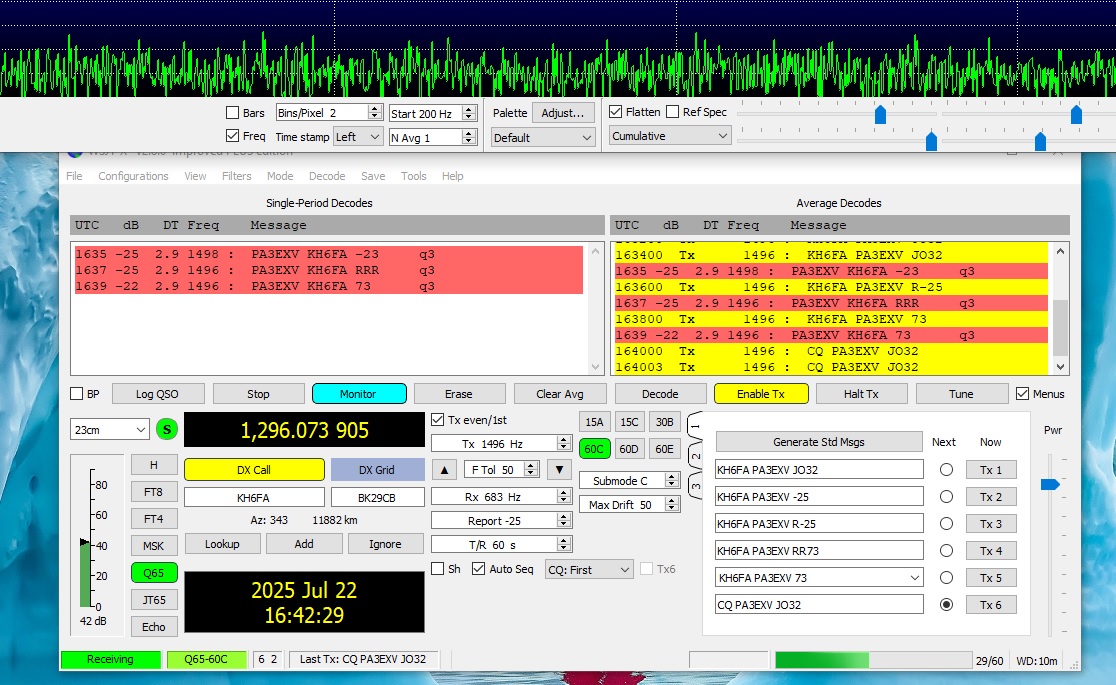 PA3EXV KH6FA 23cm QSO
PA3EXV KH6FA 23cm QSO
SM4GGC Stig
I have reconfigured my antennas again since my last report in April due to a problem with balance and heavy total weight in the antenna mast. Info and pictures of old system https://www.sm4ggc.se/ The new configuration consists of 6X 26 el H-pol who are stacked to minimize side lobes and impact from surrounding metal parts. Own Echo is now measured down to -10.6 dB with 350 W at the antennas.
Some more interesting QSO and reports are:
250722 G0JDL with 2x14 and 200W RX -22 TX -22
250722 G3YEG with 9 el antenna under his roof RX -22
250722 OZ7IGY with 4x27 el and 100W RX -21 TX -14
Other QSO worked with this setup since 250716: SP2WRH, ON7EQ, IZ6MVK, DC1RDB, GD0TEP, VE3CIQ, RD3FD, PA2V, DL8DAU, PA3FWV and NY1V.
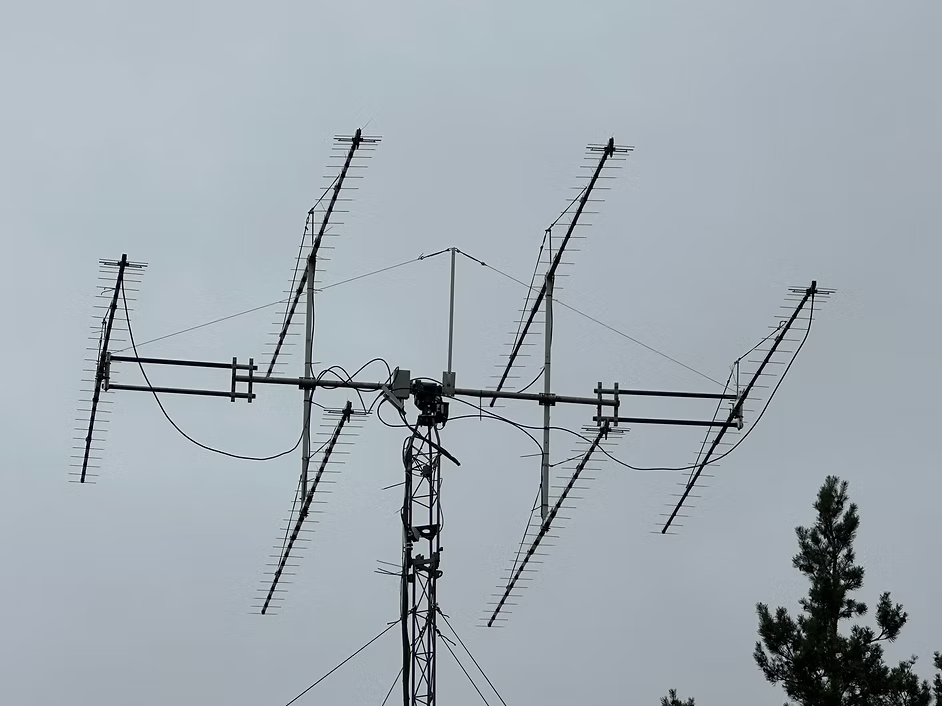 SM4GGC new antenna configuration
SM4GGC new antenna configuration
Antenna modelling performed with new setup:
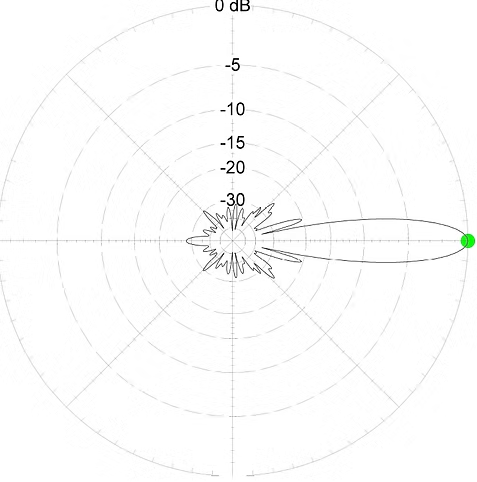 SM4GGC EL modeling
SM4GGC EL modeling
EL 6x26 el Gain 26,86 dBi. Front/Sidelobe 20,26 dB
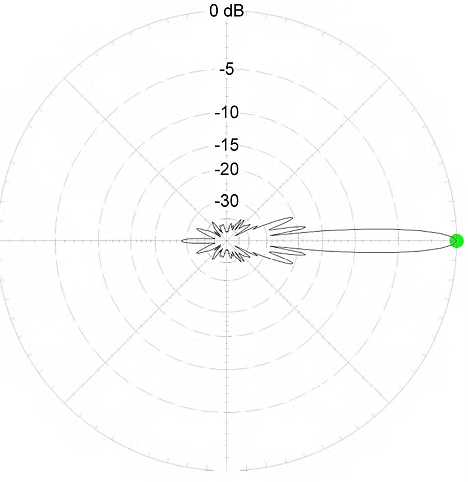 SM4GGC AZ modeling
SM4GGC AZ modeling
AZ 6x26el Gain 26,86 dBi. Front/Sidelobe 18,13 dB
SM6FHZ Ingolf
During the DUBUS 6 cm event I was plagued by an intermittent Rx-function in the morning that led to a few not so successful QSO attempts. I apologise to the stations I tried to work and then just disappeared. I eventually found a damaged wire in the cabling to the RF-head that was quite easy to fix when identified.
I worked 12 stations during the Dubus (including 2 initials) event timeframe but disqualified myself by using the HB9Q logger to sked OE9ERC after a few unsuccessful attempts to tailend when heard on the band. OE was a new DXCC for me. (Ingolf, you can submit a perfectly valid contest entry if you simply leave out the OE9ERC QSO. Confirmed by Joe DL8HCZ. Ed)
On Sunday morning (20th July) I worked tvo more initials on 6 cm initiated on HB9Q.
WA6PY Paul
1296 on April 5-6: CT1DMK DF3RU DL4DTU DU3T F6ETI F6KRK G0LBK G3LTF G4CCH IK3MAC K5DOG NQ7B OE9ERC OH1LRY OH3LWP OK1KKD OK2DL OZ6OL PI9RD SM3BYA SP3TLJ SP6JLW SP9VFD VA7MM VE6TA VK5MC
3400 on May 3: DF3RU G4CCH KL6M OH1LRY OH2DG OH3LWP PA3DZL SP6JLW SP9VFD VE6BGT
24 GHz on June 21: DB6NT OZ1LPR SA6BUN
24 GHz on June 24: SP3XBO SP6JLW
Currently I am using RW1127 28 W out and DU3T LNA
I was QRV on 5760 MHz on 19 July 2025 and worked SP6JLW OK1KIR PA3DZL G3LTF DB6NT OZ1LPR SA6BUN and OH3LWP. I was calling CQ and looked for stations during my VK JA window, but had no luck.
I have elevated and fluctuating noise floor due to the wideband QRM. Sometimes I have a strong noise bursts every few seconds lasting for few seconds 10-20 dB above my average noise floor. I was calling QRZ few times. For me, the best way to respond for QRZ is to repeat only own callsign several times with distinct space between callsigns. For example if the call is AK7WA and there is no clear spacing while repeating callsign it can be interpreted as K7WAA. For me repeating each letter 3 or more times can create confusion.
I plan to be QRV in ARRL EME MW Aug 16-17. 10 GHz both days and 6 cm first day and 13 cm second day.
I am not sure what bands I should choose for the August contest. I will setup 10 GHz on the 3 m dish and probably 24 GHz for September. On my 3.6 m dish I will keep 6 cm feed in for the first day and I will change to 13 cm for the next day. I will be helpful to know others' plans. During the contest it takes me too much time of my short window to EU to change the setup to different band without even knowing on which band we have the most activity.
(6 cm on day 1 and 13 cm on day 2 would work for me Paul, what do others plan? Ed)
YO8RHI Adrian
After my first receptions on 24 GHz EME a few months ago, I got courage and I am very happy to announce that I will soon complete the TX part. The mechanical part has become more complicated, the weight of the antenna focal point assembly has increased and I have to add two counterweights to compensate for the effort of the motor on the Elevation, etc.
I hope to manage to get 20-25 W from the RW1127 (WR42in / WR42 Out). Some WR42 flexible waveguide for the TX output is on the way. I think I am on the right track and I hope that soon I will be QRV in 24 GHz EME as well.
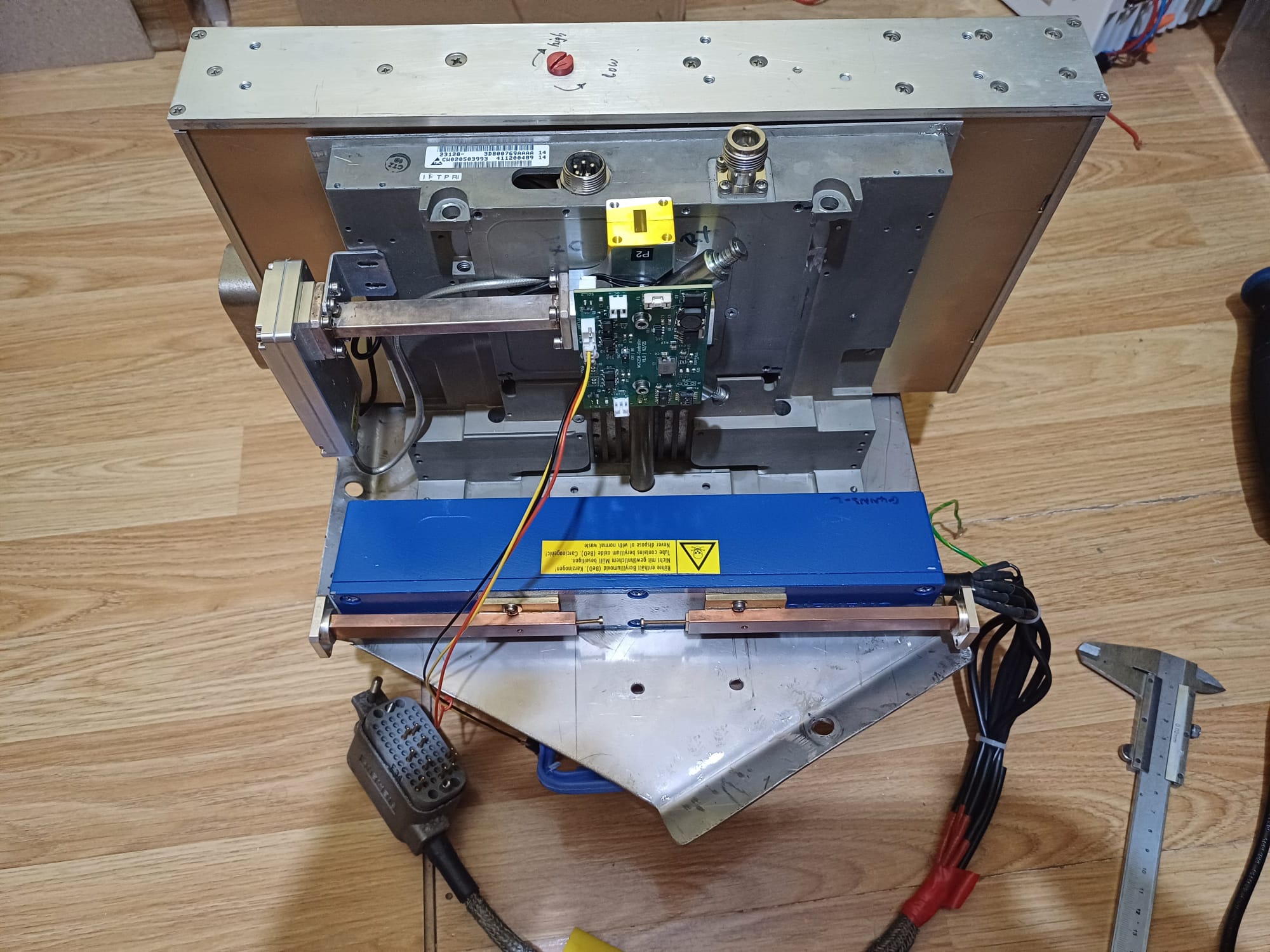 YO8RHI 24 GHz EME setup
YO8RHI 24 GHz EME setup
ZS4TX Bernie
I have been trying to work Frank KH6FA [BK29CB] on 23 cm EME for about 8 months and we finally made it on 2025-06-08 at 13:40Z. This distance was just below the current published record distance for 23 cm EME.
The next day I managed to work KH6AF again and a few minutes later Rob NH6V called me from BL20BB which exceeded the old record distance that EA8DBM and VK4CDI set up in 2017 by 96 km. The K7FRY distance calculator shows KG30bx to BL20BB as 19019.98 km
Both KH6FA and NH6V were still decoded at my station when the moon was already at 2 degrees below the horizon for them. The picture of the NH6V setup shows his excellent moonset. The KH6FA location is just as good, except for some tree blockage at the most critical Azimuth to work ZS. With around 4 degrees of common moon between us at best, this definitely helped to complete the contacts.
NH6V used an ultra-light-weight 2.4 m hex wire dish and 100 W for the contact. Some of the equipment used was provided by Frank KH6FA. On the ZS4TX side I used a 3.6 m dish and 200 W. This specific dish was used previously by Alex HB9DRI/ZS6EME during his stay in South Africa.
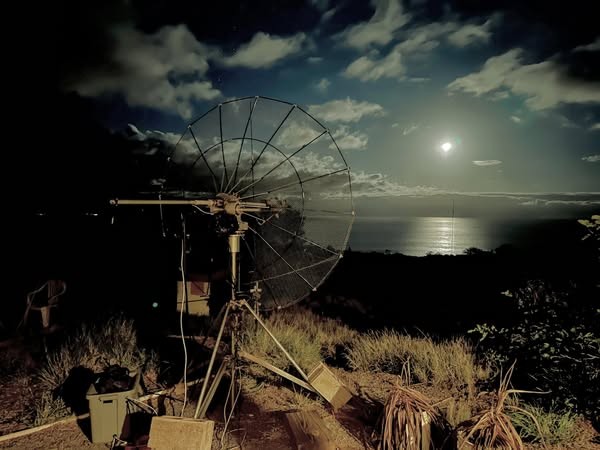 NH6V dish
NH6V dish
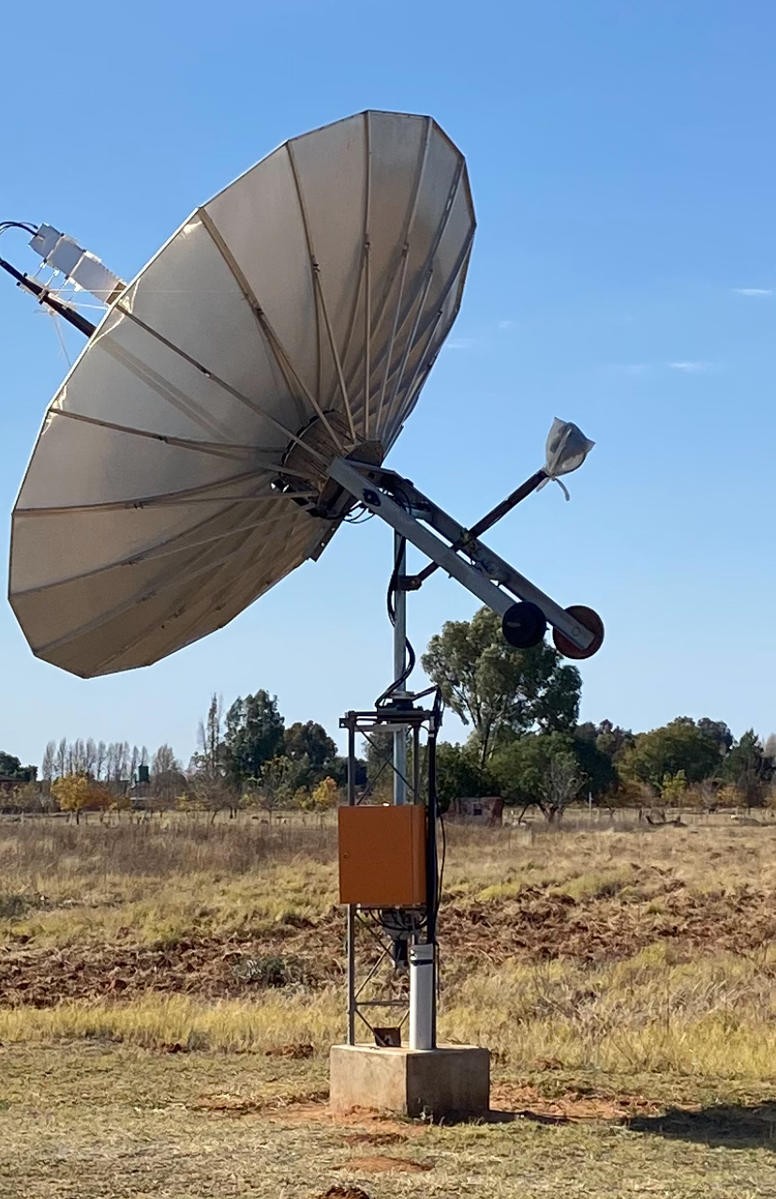 ZS4TX 3m6 dish
ZS4TX 3m6 dish
G4RGK CW Initials List
Dave G4RGK's CW Initials list has been updated and can be found at: http://www.g4rgk.co.uk/Initials/index.html
2025 23 cm & 13 cm Funtests
Peter G3LTF
The top Fun Maker in the F5SE Memorial 1296 SSB Funtest, May 24th, 2025 is PI9RD with 35,700 points, similar to OK2DL’s score of last year but about one third of the 2022 score of DG5CST. SP6JLW was the runner up. Activity was moderate, there were about 30 stations active from 14 DXCCs and 2 continents but we only received 8 logs.
In the 13 cm Funtest, May 31st, 2025 the order was the same, PI9RD in the top spot followed by SP6JLW. Activity on 13 cm was low, only 9 stations were active from 5 DXCCs, there was no activity outside Europe.
Congratulations to the PI9RD team and thanks for their support of the contest, and for giving several stations their first ever EME SSB QSO.
Both contests, especially 13 cm, suffered from the presence of competing interests; dxpeditions that could not be foreseen when the dates were chosen. I suspect that is unavoidable with the way things are these days but suggestions about dates are welcome. It would also be good to see more participation from outside Europe.
The winner on both bands, PI9RD will receive the distinctive certificates at the next EME conference in Tenerife May 28th-31st, 2026.
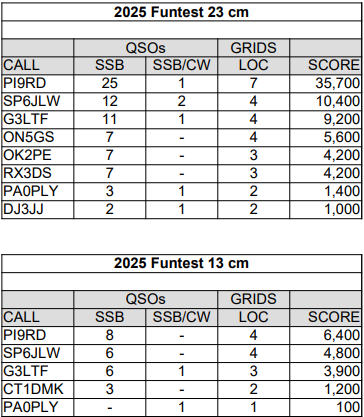
60 Years since the second Arecibo operation July 1965
Peter G3LTF
In the first 432 MHz operation from Arecibo, KP4BPZ, on June 14th 1964 only 4 stations were worked because only a few were prepared (and believed it would actually happen!) Sam Harris, W1FZJ who edited the “World above 50 MHz column in QST” made sure that the community was well prepared for the next time, 3rd July 1965. The prior issue of QST gave transmission times, where to point the antenna (relative to the sun) and also carried an article “How high the moon” on how to calculate its position. A second date 24th July was also scheduled. On the first day, with a 2hr 15 minute window, 28 stations were worked and on the second day another 21 plus 18 duplicates. The table, taken from QST September 1965, details most of the antennas used, mainly parabolic dishes but quite a few yagis and big collinear arrays which would have had mesh reflectors.
The typical receiver at that time would be a crystal diode (1N23) mixer in a cavity with tube preamplifiers but also, increasingly, transistors, Texas Instruments TIXM-05 or GM0-290 with a noise figure of about 4 dB. Many stations across Europe and North America, some with small yagis with no elevation, reported hearing the signals. Among them were future EME stalwarts GW3MFY and OK2WCG, later ZS6AXT. VE4MA was also inspired by this event.
John W2BYP sent me a page with some photos of the K2CBA operation, see picture; George, K2TMB is still around. There are a lot of photos from QST reproduced here:
http://www.ok2kkw.com/eme1960/eme1960eng.htm
At KP4BPZ the team were running three receivers, two Collins R-390As and a Collins 75S-3 and also a 125 kHz bandwidth recorder which was used after the event to list a further 16 stations (see table 2) Sam wrote to me afterwards to say that on the tape he could copy my ssb signal.
The transmitter exciter at KP4BPZ was interesting, a R&S synthesiser on 25.215 MHz multiplied x8 in a 4X150G (201.7MHz) and then doubled and mixed in a varactor with the 28 MHz signal from a Collins 32S1. When they came on on July 3rd their signal had a distinctive buzz (I remember it well) due to some 60 Hz FM somewhere in the chain. This was eliminated by the 24th. It was never clear how much power KP4BPZ was running but remembering it was a radar it was certainly “adequate”!
A highlight for me was copying signals from the 150 ft dish at WA6LET, 339, and two months later, in September 1965, I and 10 others managed to work them, but then it was not until April 1967 when K2MWA/2 (using the Crawford Hill dish) started tests that activity really got going on 432 MHz.
https://www.microwavers.org/eme2012/files/friday/G3LTF-EME-Systems_EM2012-short.pdf
It was 1975 before Arecibo was activated again and several stations have written to me with memories of that event.
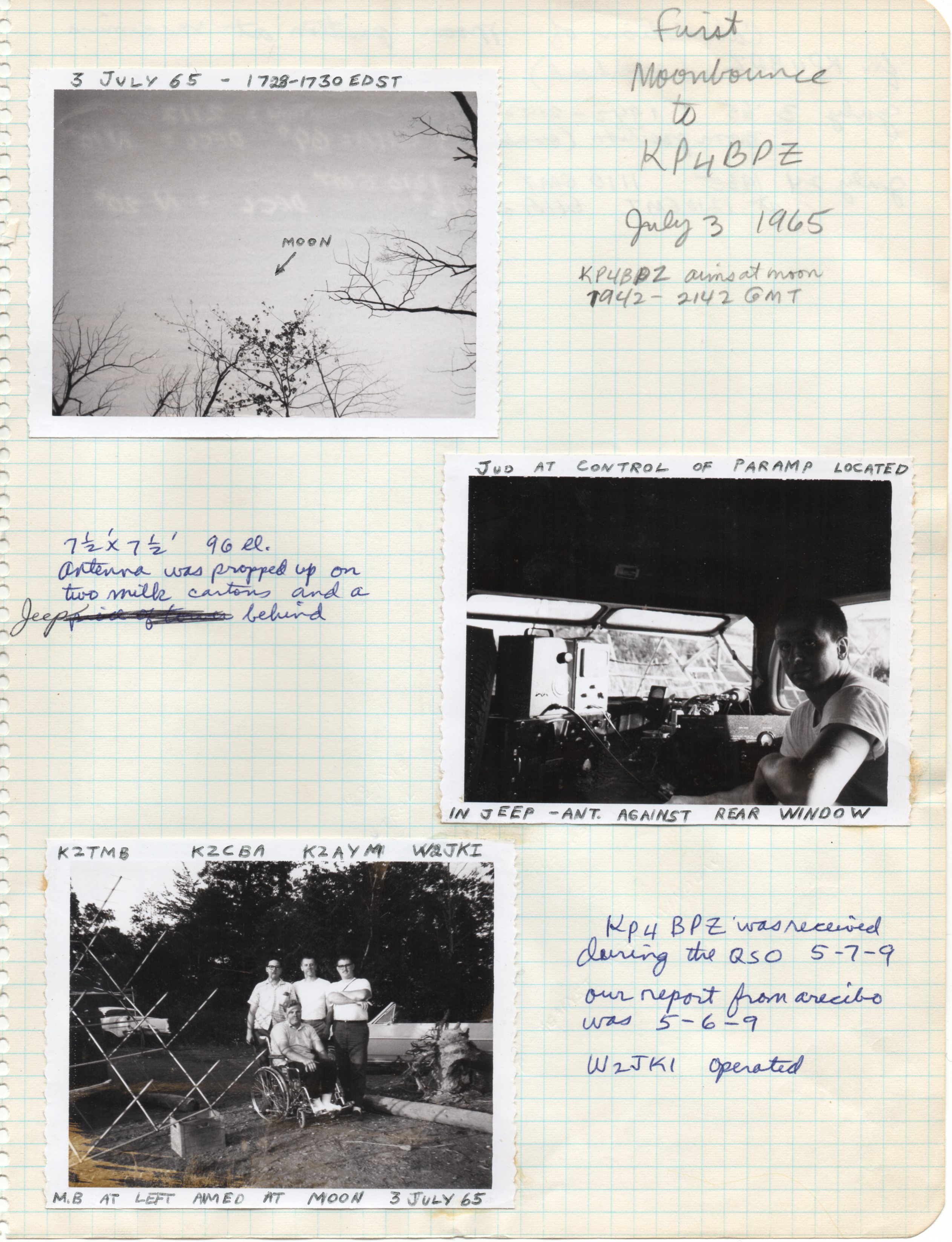 Arecibo K2CBA EME 03 Jul 1965
Arecibo K2CBA EME 03 Jul 1965
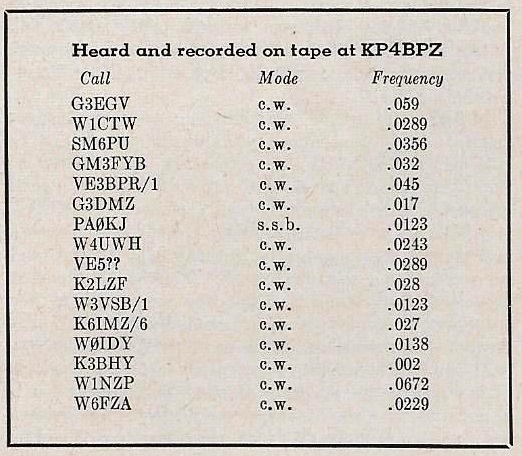 Arecibo QST Sep 1965 Stations Heard
Arecibo QST Sep 1965 Stations Heard
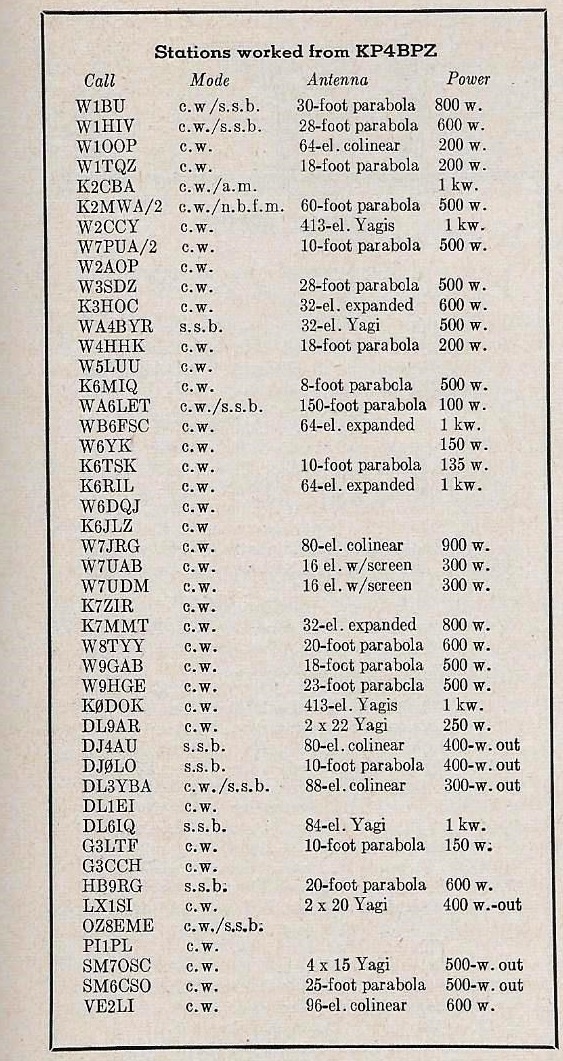 Arecibo QST Sep 1965 Stations Worked
Arecibo QST Sep 1965 Stations Worked